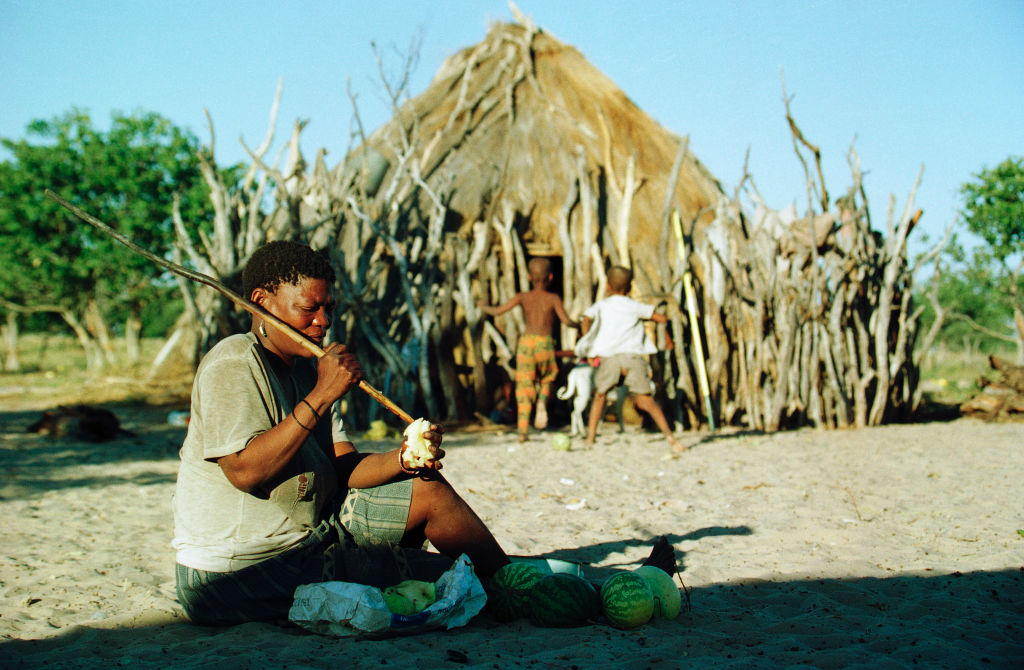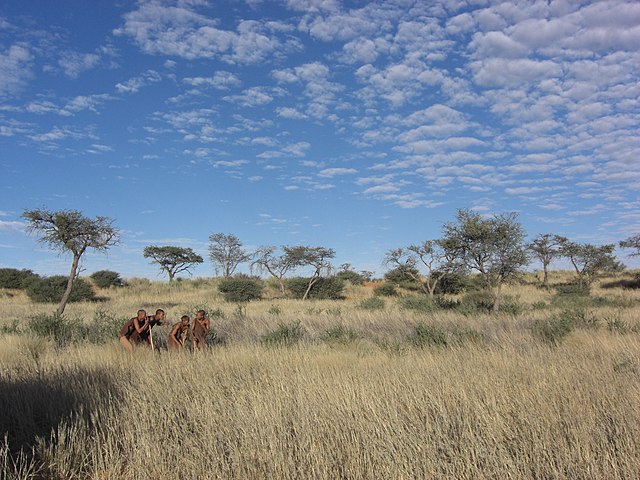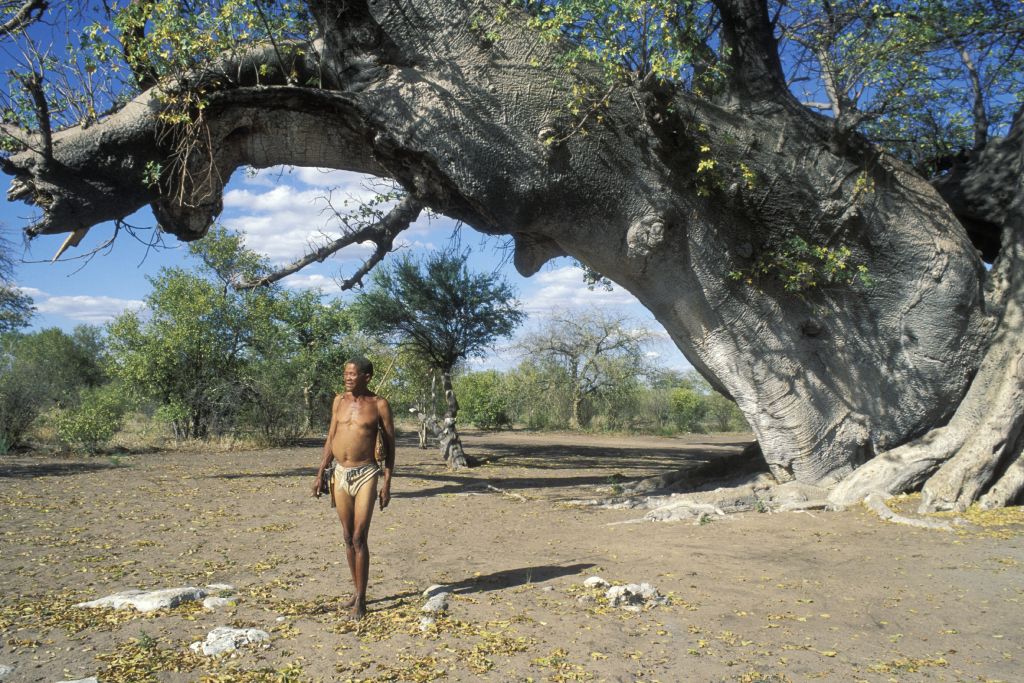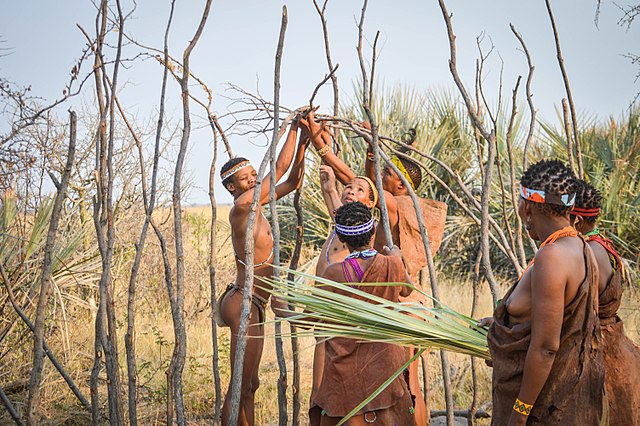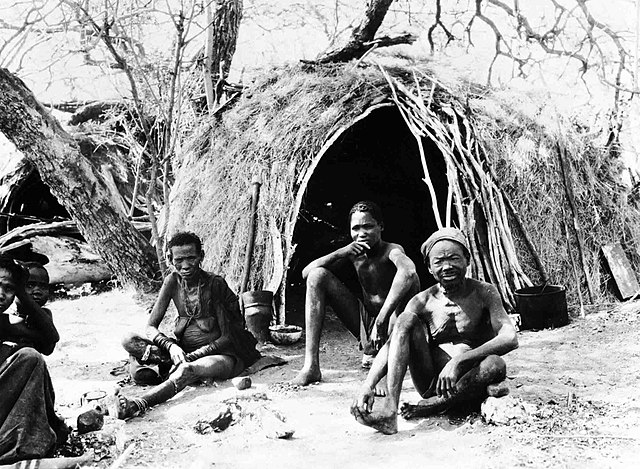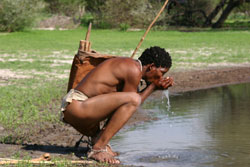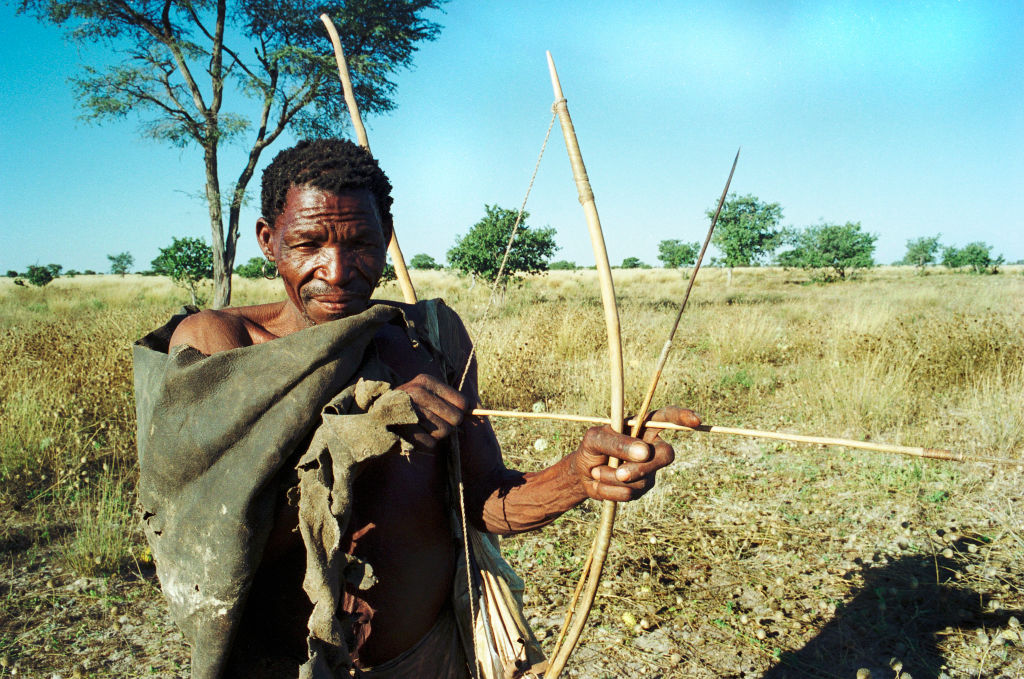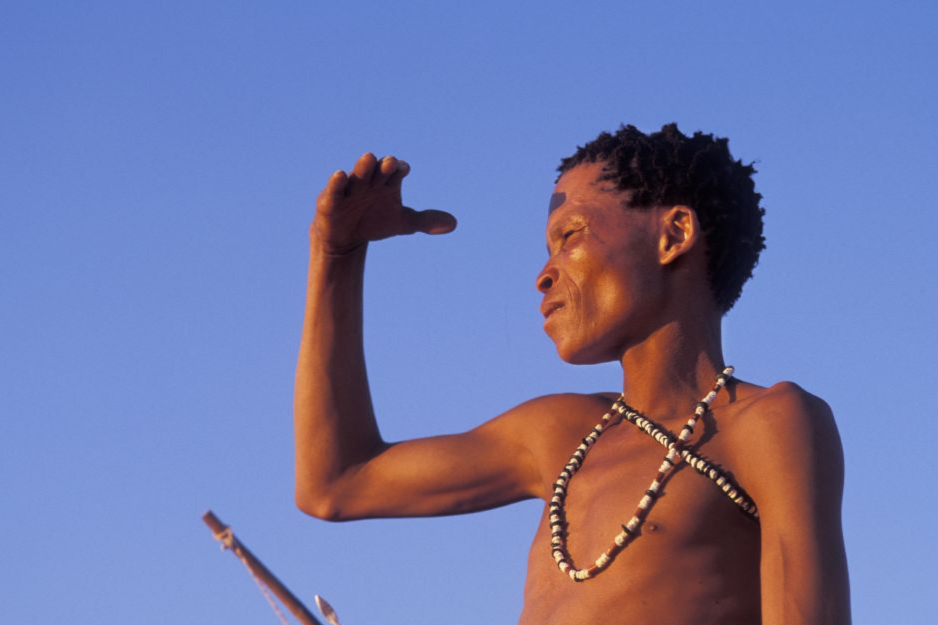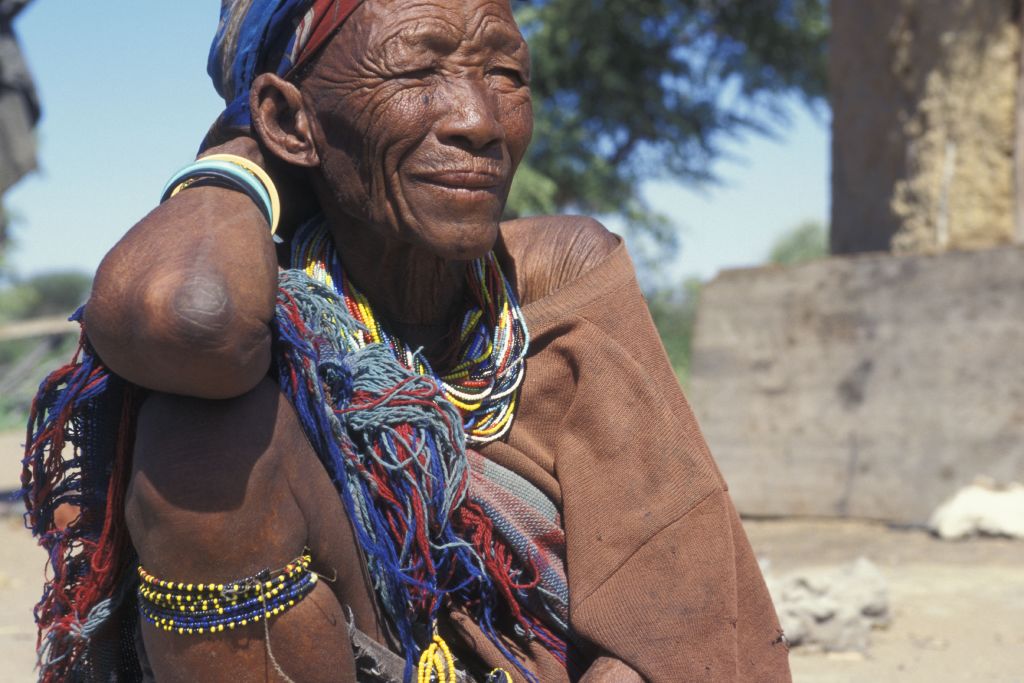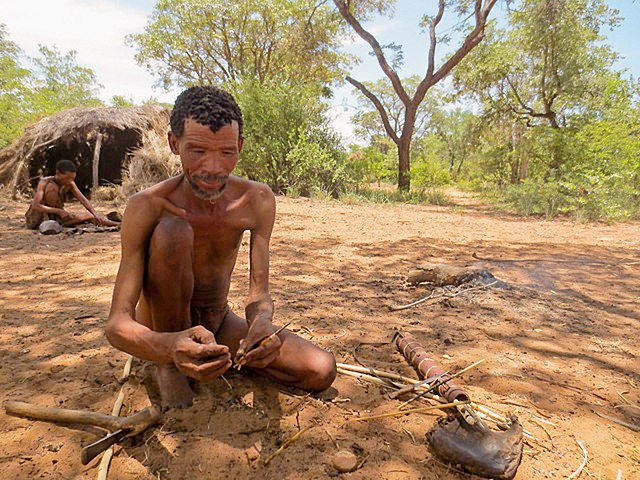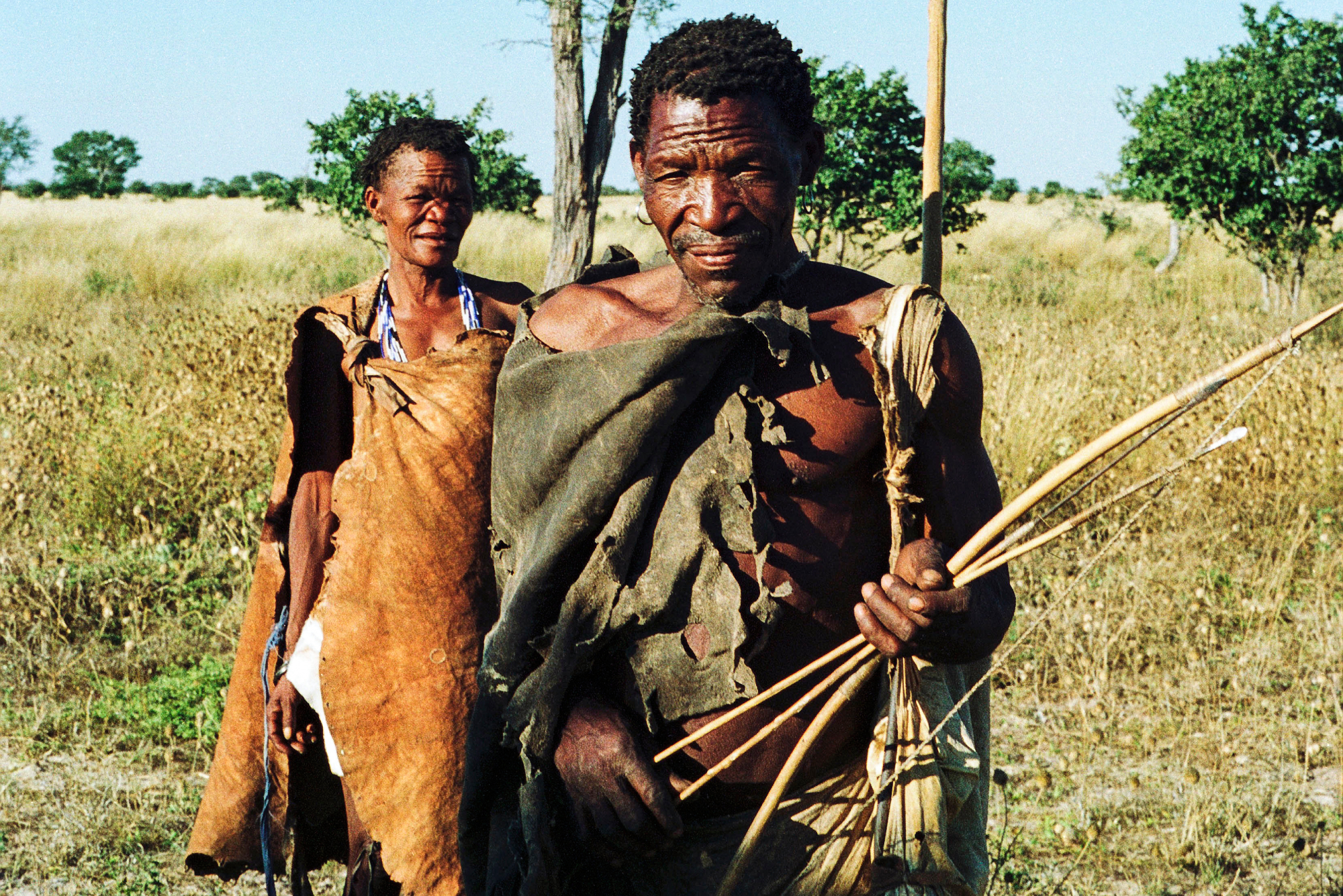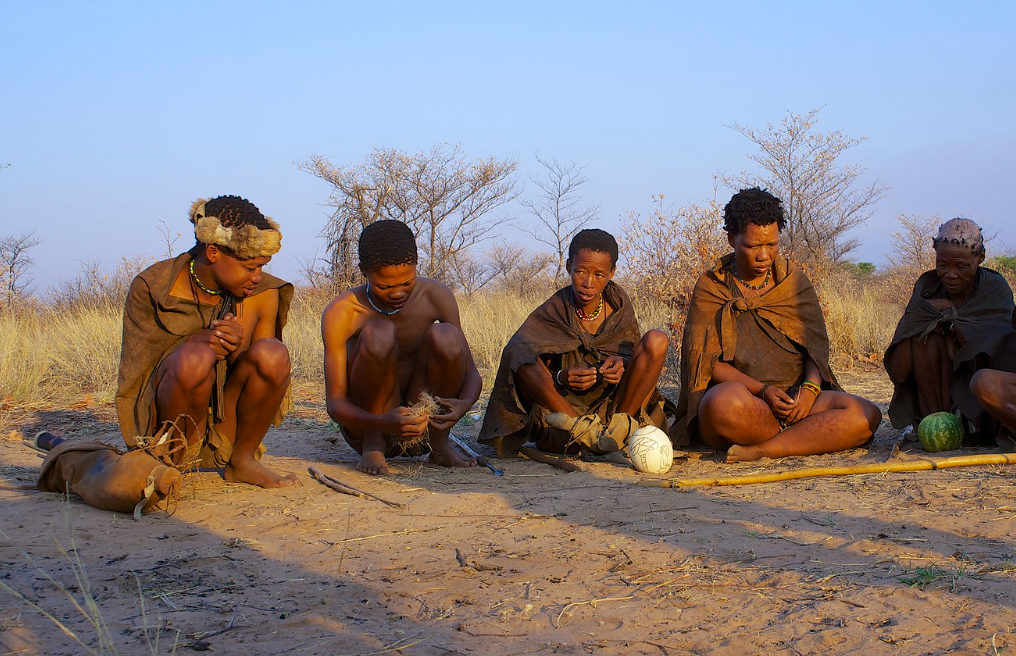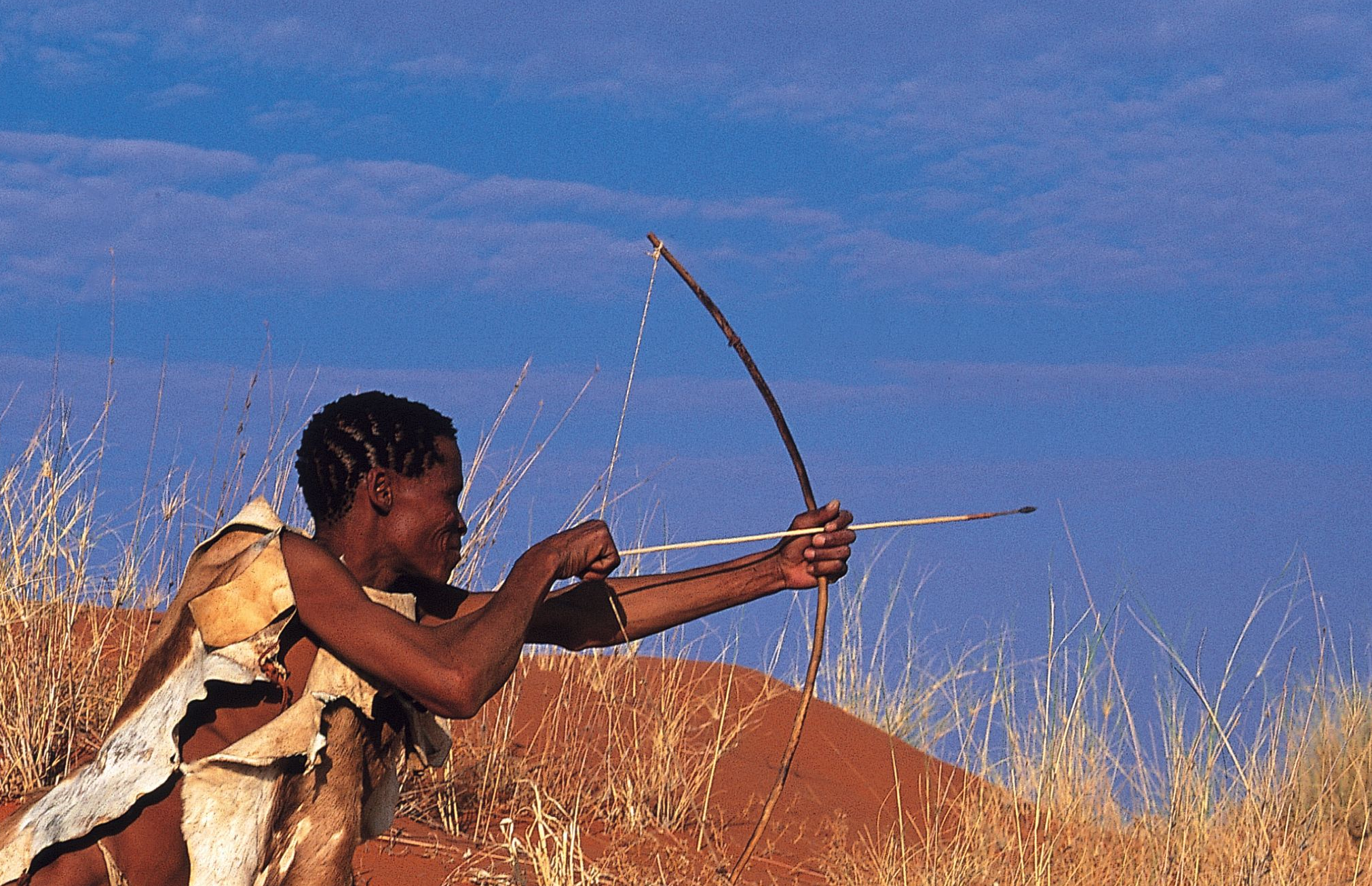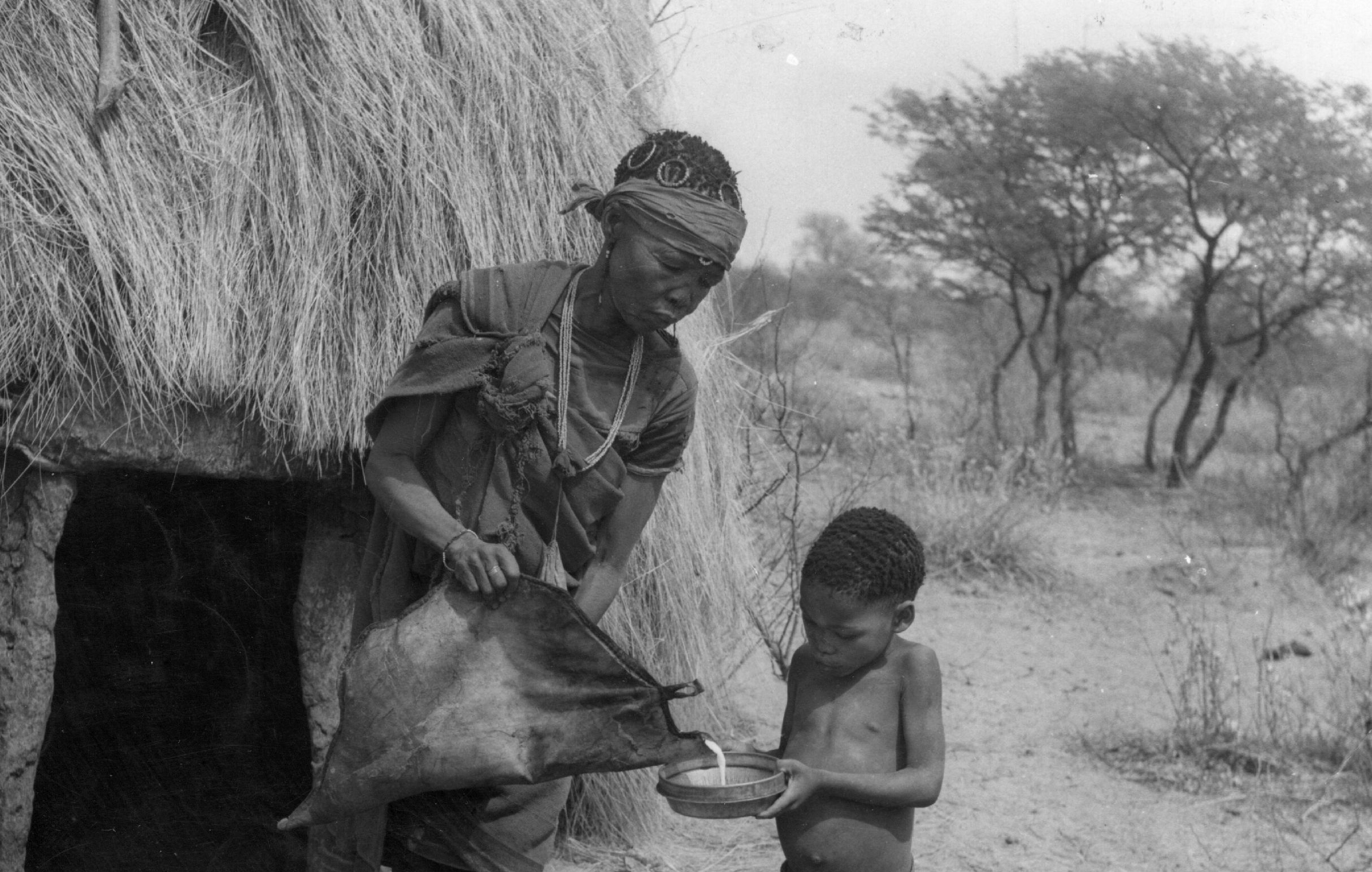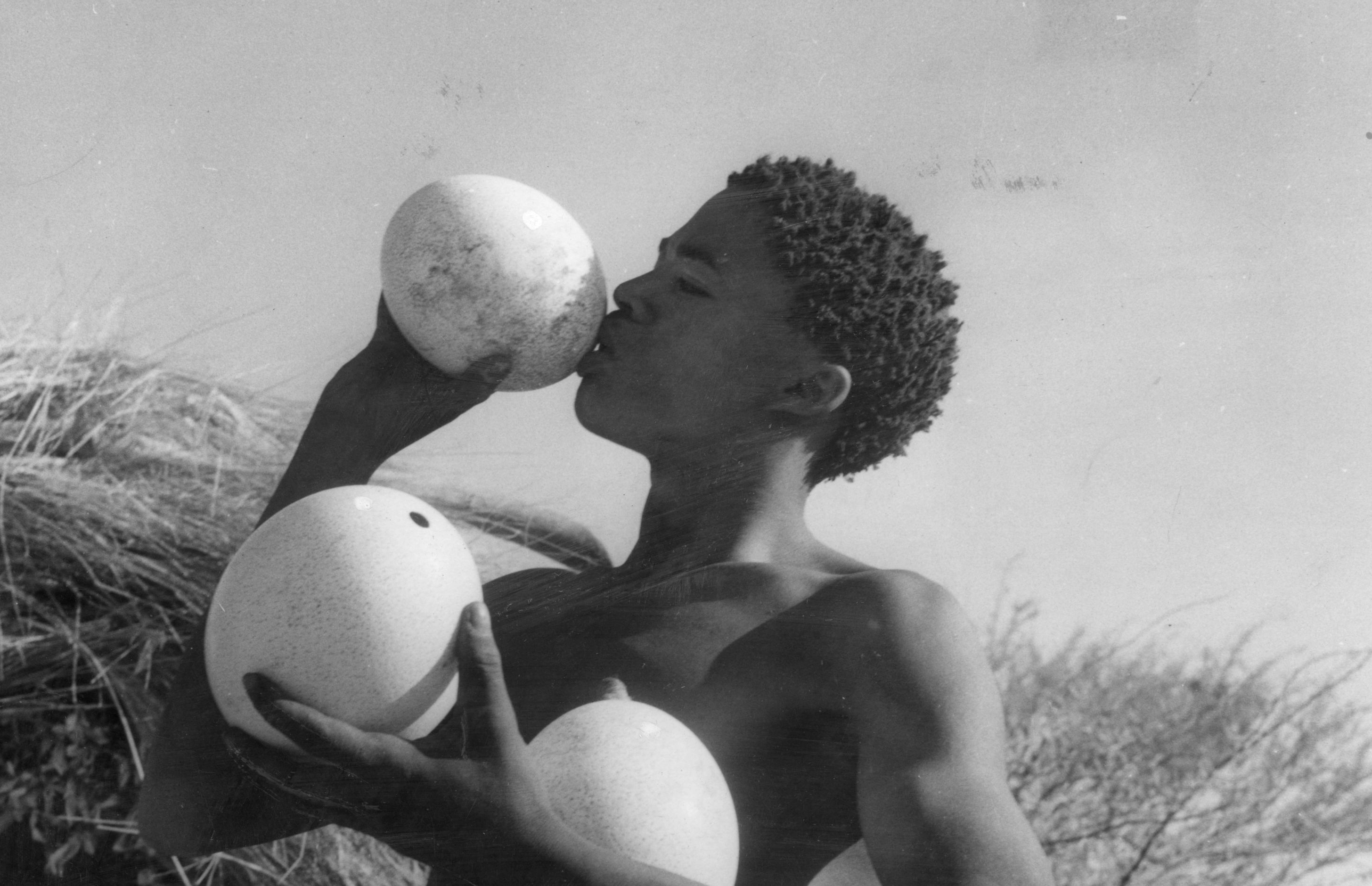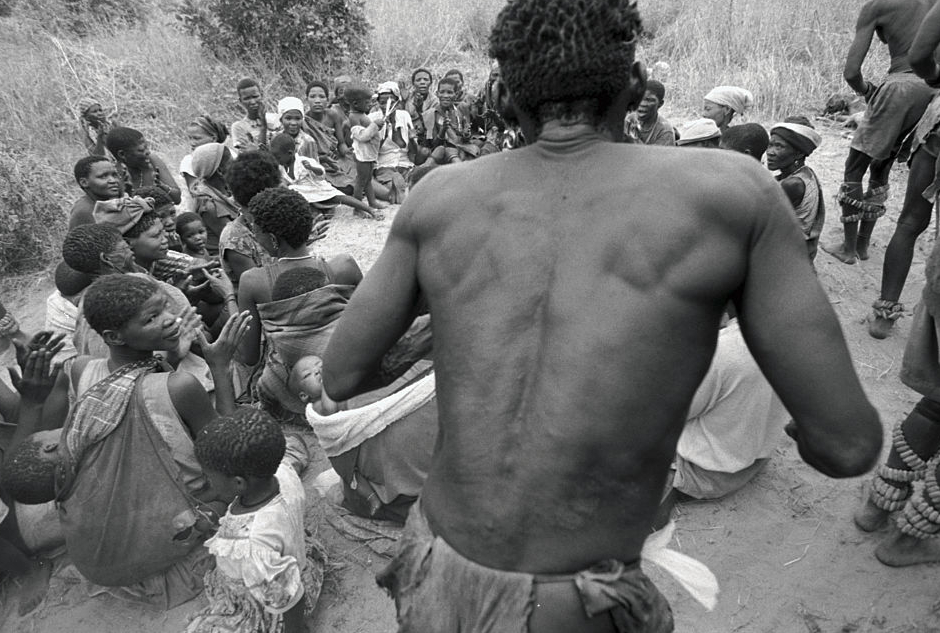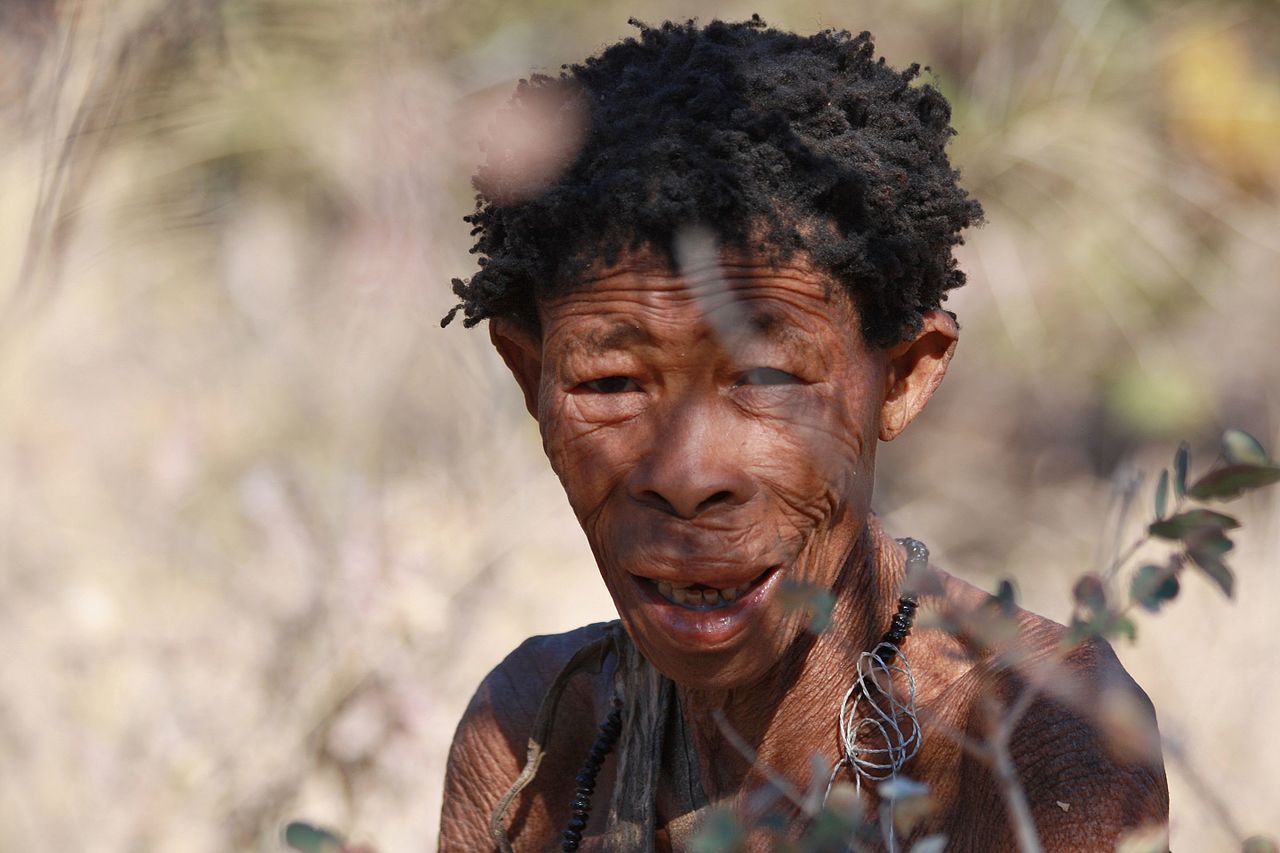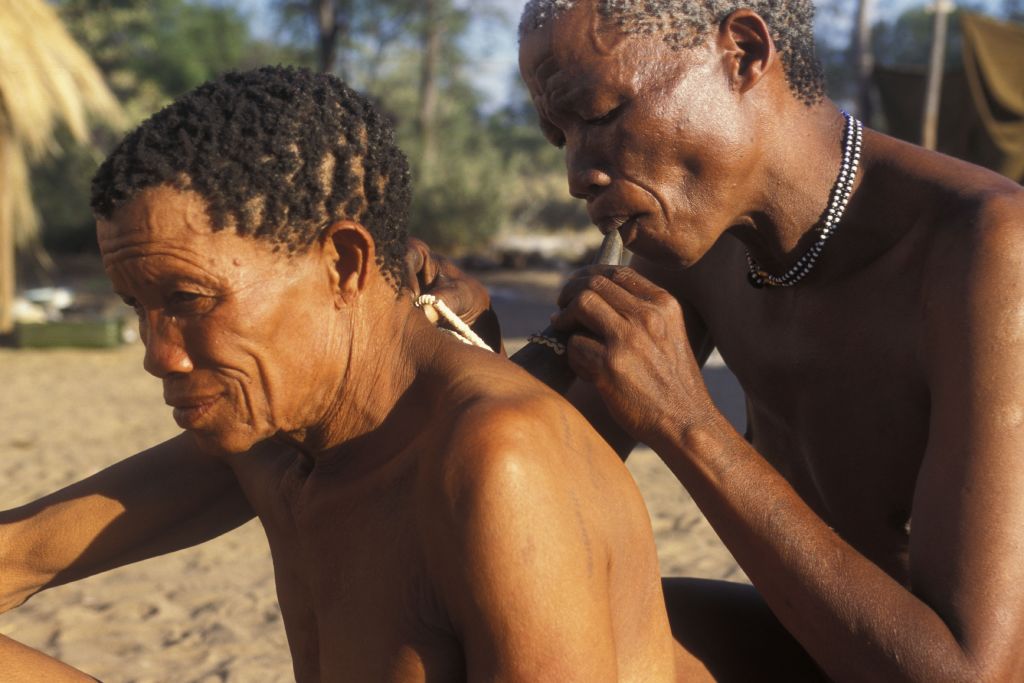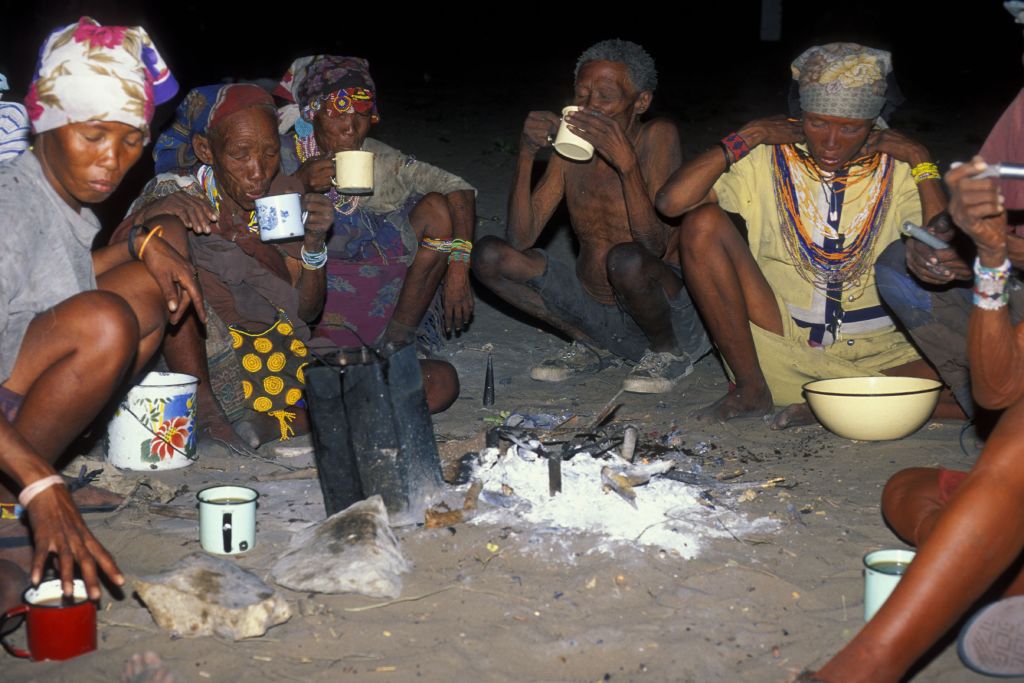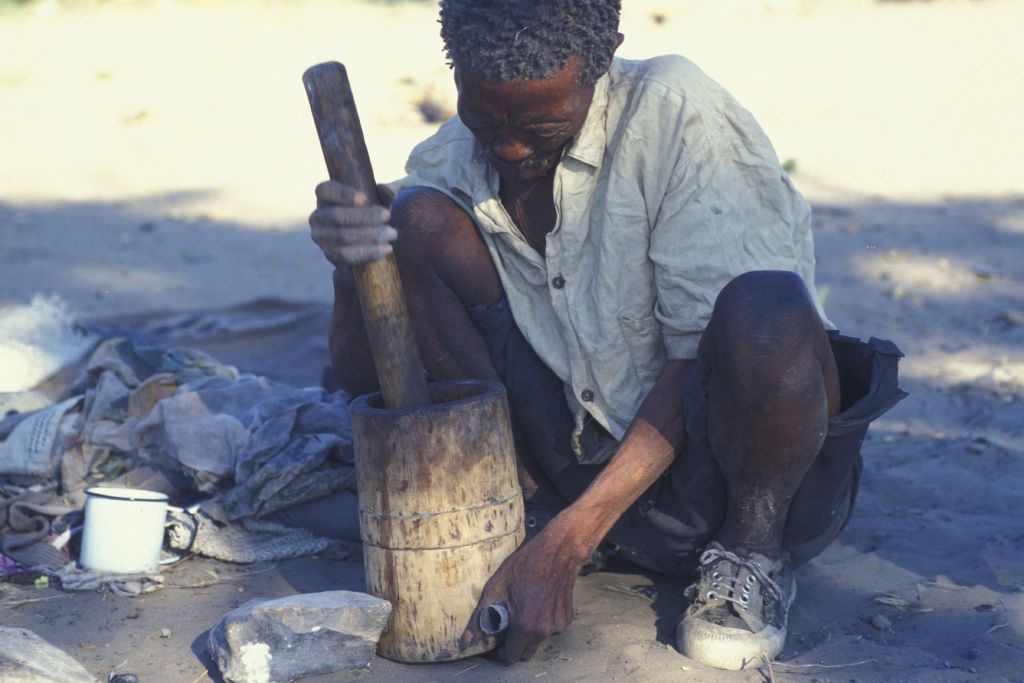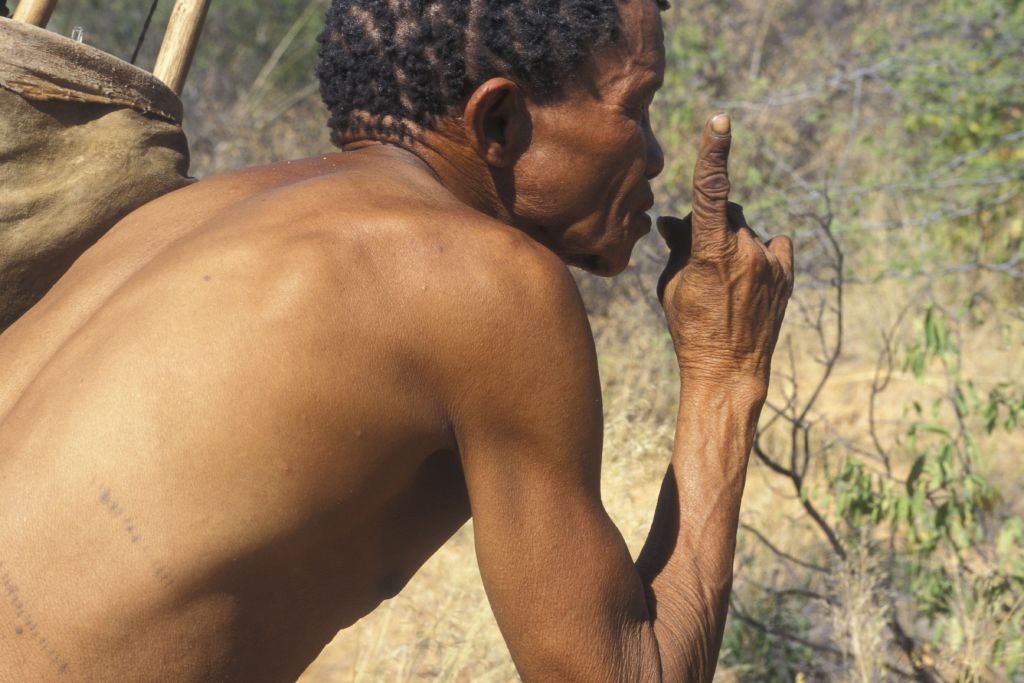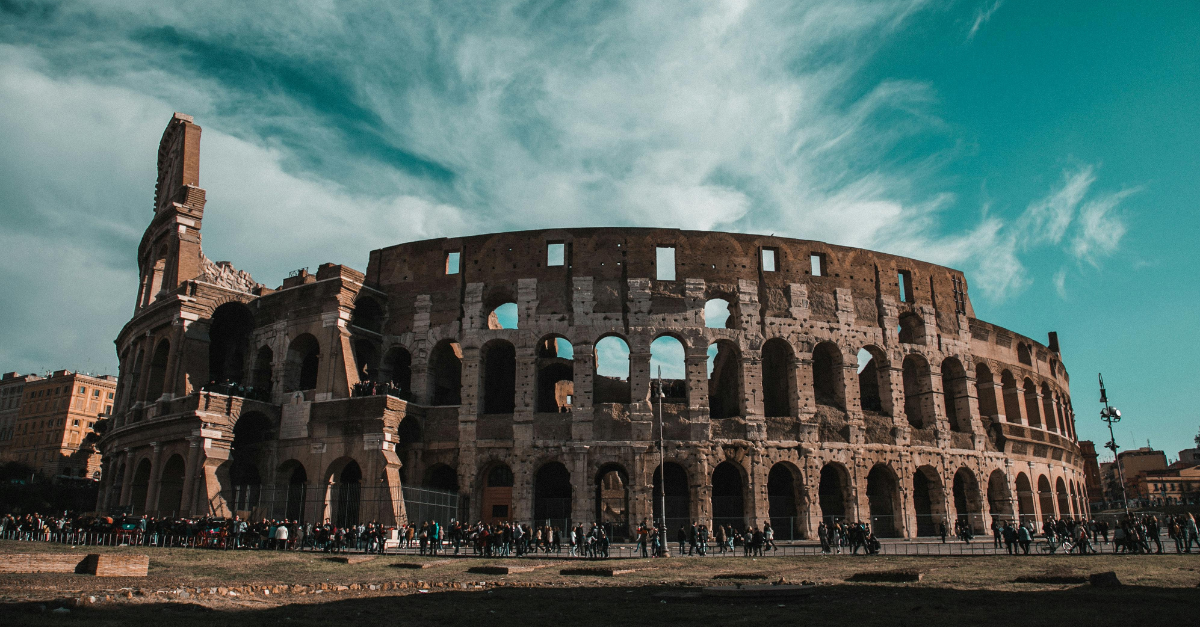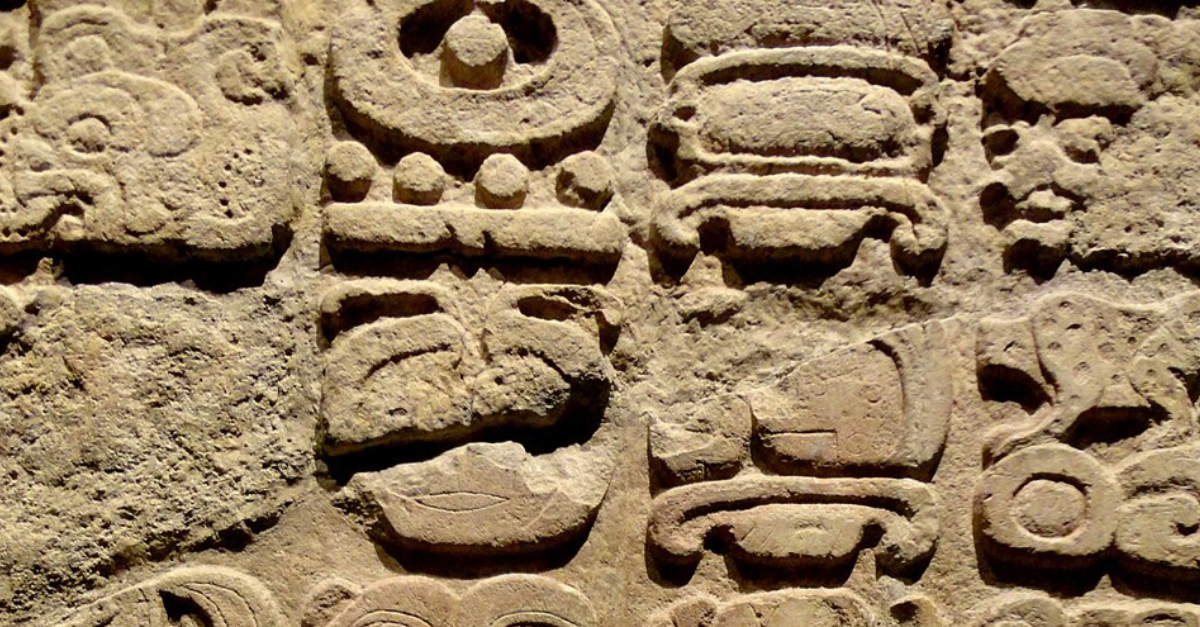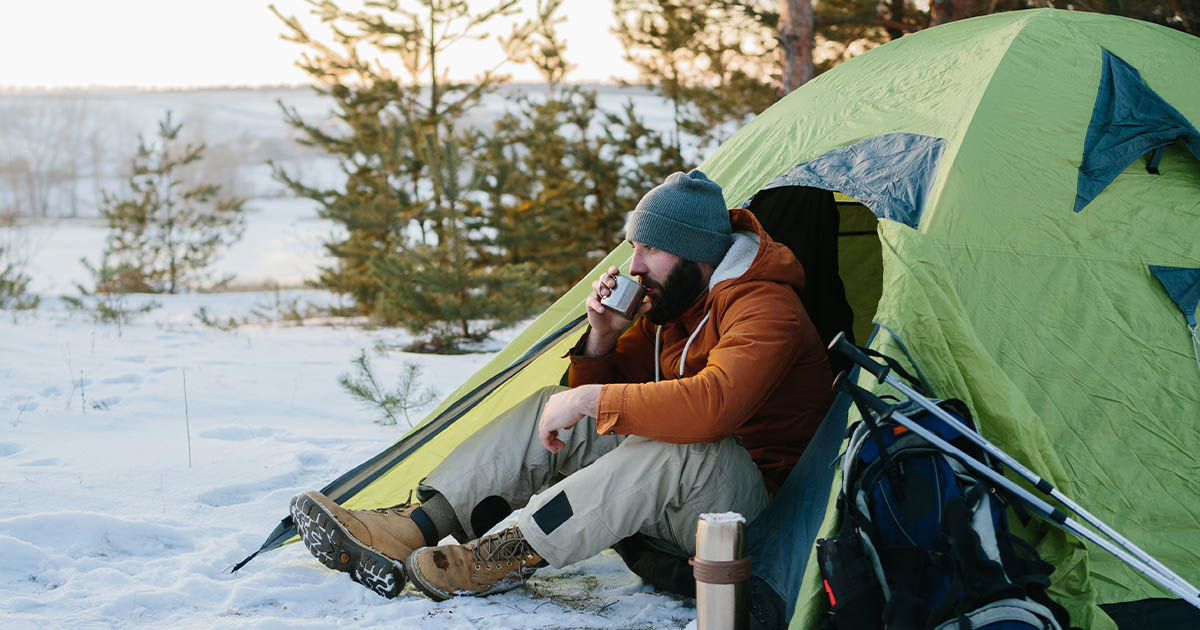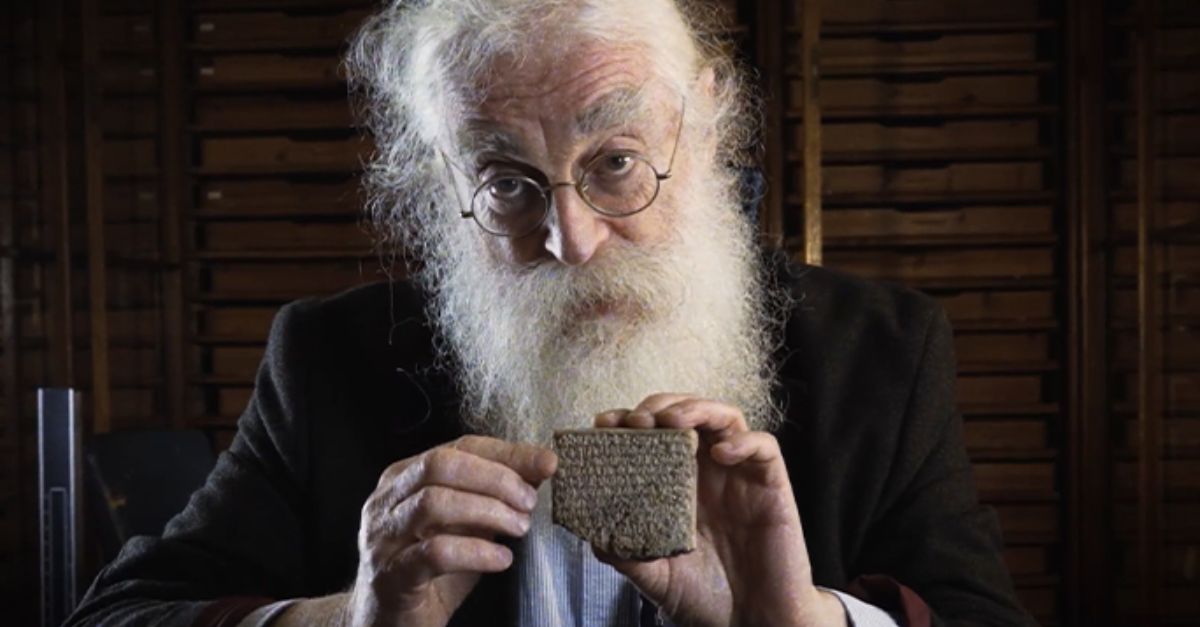The !Kung
There was a time when all humans lived as nomadic hunter-gatherers. And while many of us have since adapted to colonization, there are a few societies in the world who still practice this lifestyle today—the !Kung being one of them.
Not only do they live a primitive lifestyle, they are also one of the few societies in the world who remain a powerless culture, with men and women being equal, and having no leader. Because of this, they are said to be one of the most peaceful and stress-free societies in the entire world.
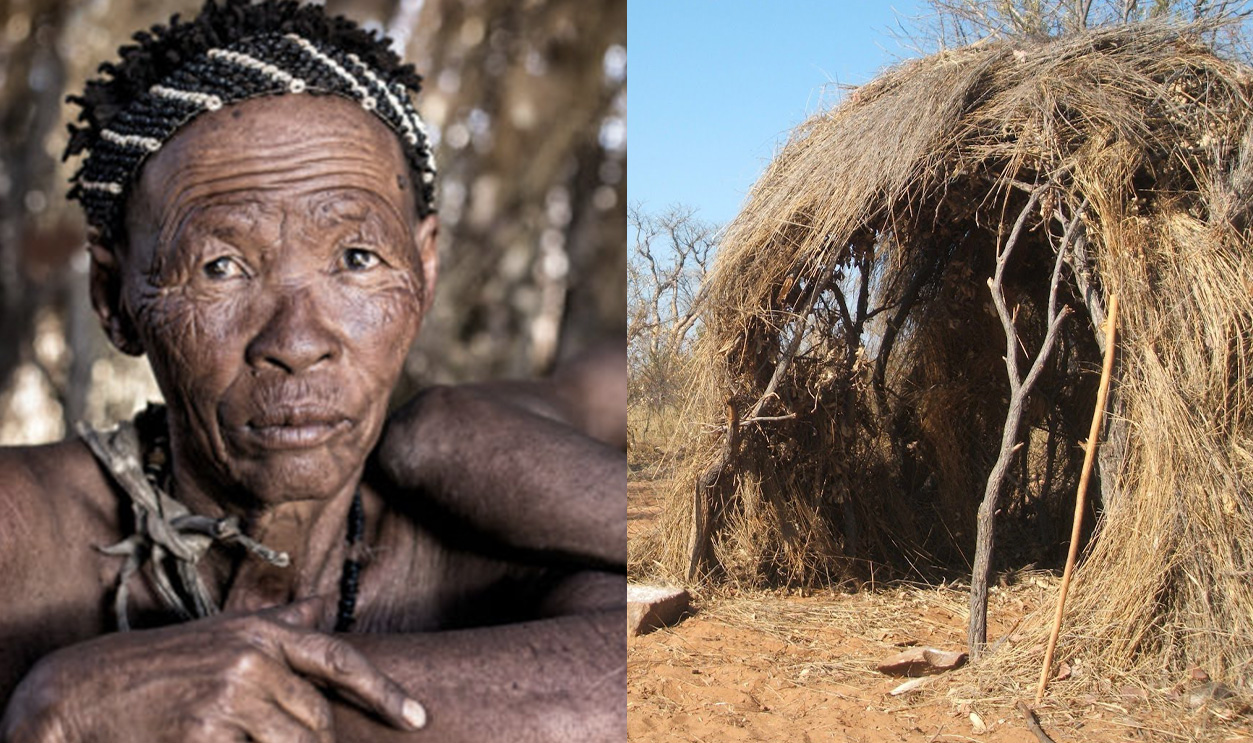
Who are they?
The ǃKung are one of the San peoples, often called "Bushmen" by the Dutch in South Africa. This band level society has used traditional methods of hunting and gathering for sustenance, and has lived a fairly nomadic lifestyle for over 11,000 years.
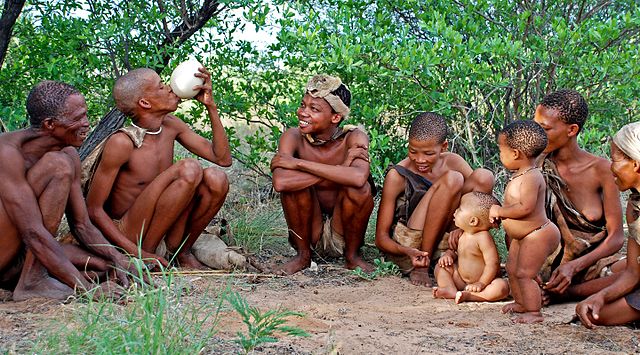 Aino Tuominen, Wikimedia Commons
Aino Tuominen, Wikimedia Commons
What does their name mean?
The exclamation mark in their name indicated that there is an alveolar-palatal-click at the beginning of the word. The names ǃKung (ǃXun) and Ju are variant words for 'people', preferred by different ǃKung groups.
However, some !Kung call themselves something else.
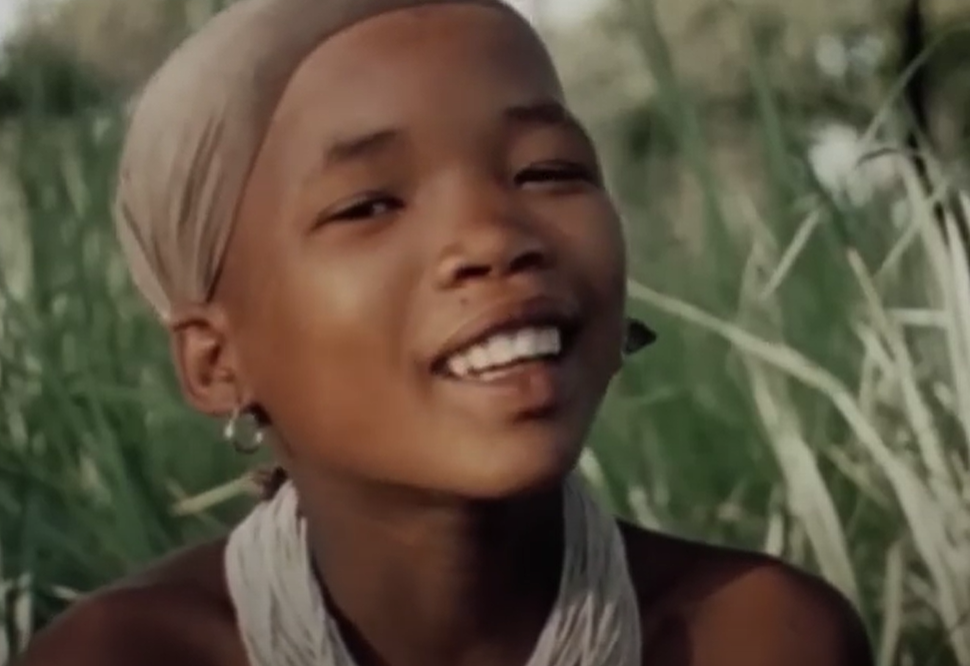 Documentary Educational Resources, Nǃai, the Story of a ǃKung Woman (1980)
Documentary Educational Resources, Nǃai, the Story of a ǃKung Woman (1980)
What do the !Kung call themselves?
The !Kung call themselves zhu twa si, which means "the harmless people," in contrast to non-San, whom they call zosi, "animals without hooves," meaning they are as dangerous as predator animals.
This preferred name fits their gentle, non-aggressive nature.
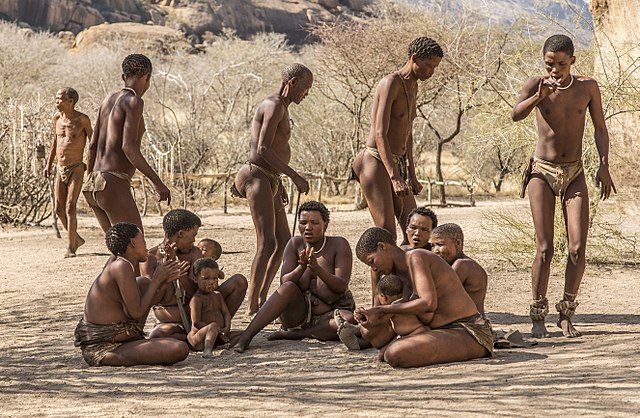 Rüdiger Wenzel, Wikimedia commons
Rüdiger Wenzel, Wikimedia commons
What language do they speak?
The ǃKung language, commonly called Ju, is one of the larger click languages and belongs to the Kxʼa language family, loosely categorized in the Khoisan language group.
What is significant about their language?
The ǃKung often communicate only by high-pitched clicks when sneaking up on prey in order to stay undetected.
What do they wear?
Traditional !Kung typically wear minimal clothing. Some will wear small cloths over their bottoms and draped across their chests. The cloths are made using animals hides. Sometimes, cotton materials are acquired through trade with other tribes.
They sometimes adorn their bodies with beaded accessories, also acquired through trade.
Where do they live?
The !Kung live mostly in the Kalahari desert, Ovamboland (northern Namibia and southern Angola), and Botswana.
While the majority of them live in colonized villages today, there are still small groups who practice their traditional nomadic lifestyle in the 21st century.
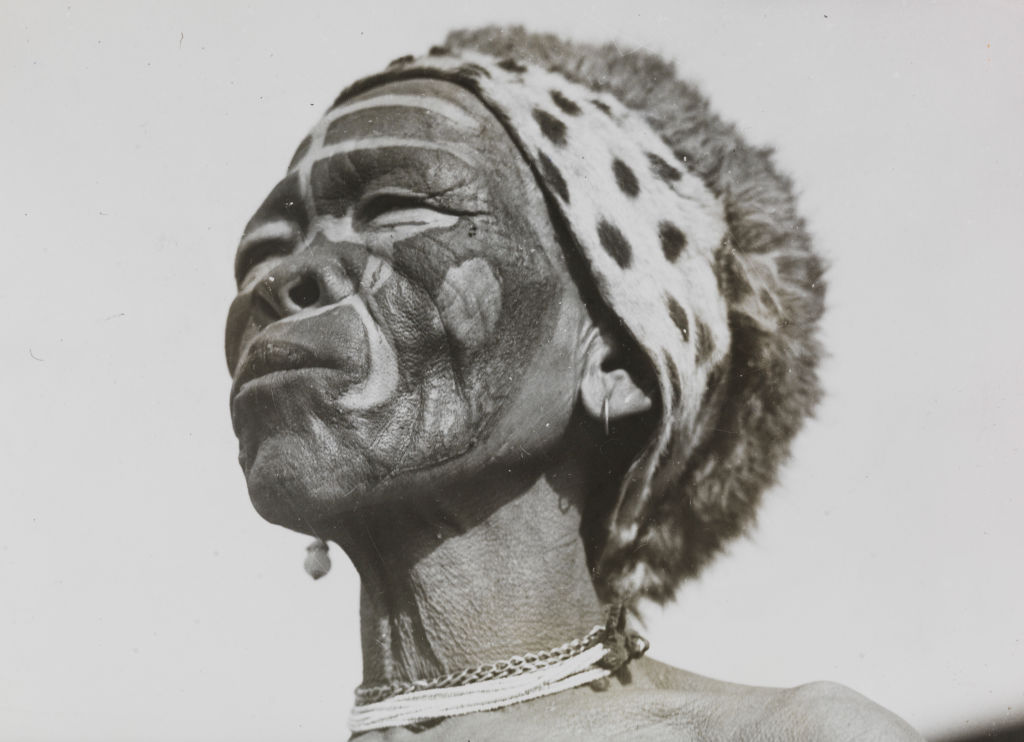 Daily Herald Archive, Getty Images
Daily Herald Archive, Getty Images
How do they live?
Traditional !Kung are nomadic hunter-gatherers. They move around based on the accessibility of their natural resources. Typically, this means they relocate with the seasons.
As a result, their homes are very basic and temporary.
What are their homes like?
Traditional !Kung live in small light-framed huts made of sticks, and saplings covered with grass. They are basically simple windbreaks, taking the shape of a semi-circle, with no closed walls.
Not only are these huts easy to build and take down, they also encourage group safety as they are open for all to see.
What do they eat?
Food is not easy to obtain in the desert, so their options have always been limited when living nomadically. Their basic diet consists of melons, seeds, nuts, and antelope.
They build temporary settlements close to water holes.
How do they acquire food?
Most of their food is simply gathered from their surroundings. They do not practice agriculture or farming as they move around every few months.
Hunting is a major part of their culture, and hunting rites are strictly adhered by.
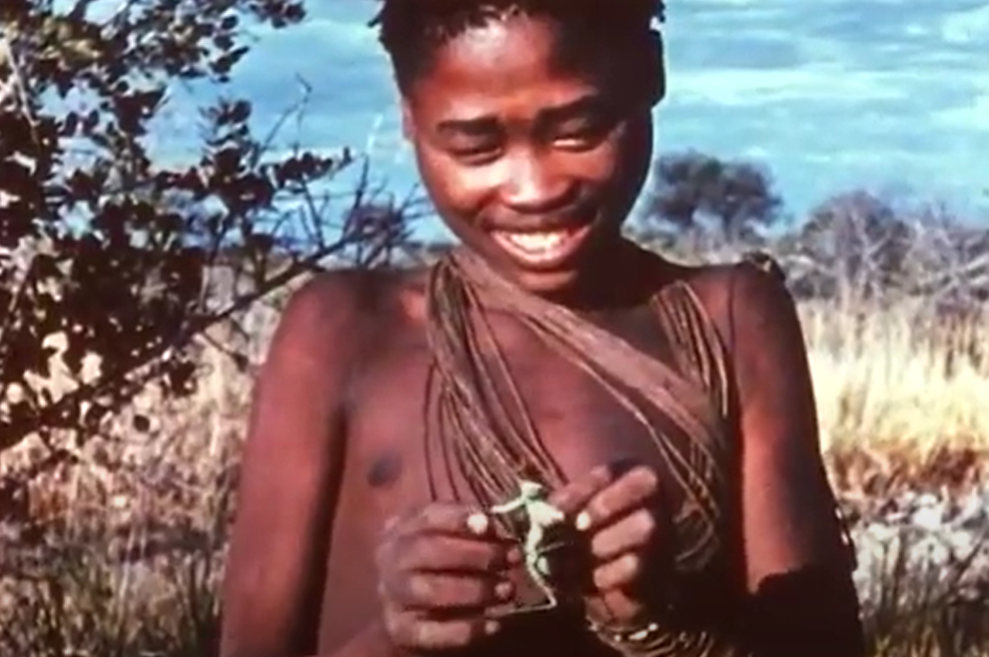 Documentary Educational Resources, Nǃai, the Story of a ǃKung Woman (1980)
Documentary Educational Resources, Nǃai, the Story of a ǃKung Woman (1980)
How do they hunt?
The !Kung are renowned trackers, so they take their time while hunting. Their hunt can take several days of tracking, attacking, and then following the wounded animal.
When they kill an animal, they do not take it directly back to their settlement. Instead, they leave the body and return as if they were unsuccessful.
This is part of their hunting ritual, which is meant to prevent arrogance amongst male hunters.
What is their hunting ritual?
!Kung are big on community well-being, and humility. So, when they hunt, they never bring their kill back and boast about their success.
Instead, they go back to their settlement and remark upon their failure, avoiding taking any credit, and accepting humility.
The animal is retrieved the next day—but even then, the credit for the kill does not belong to the hunter.
What happens when they retrieve the animal?
The day after the hunter comes back to the settlement a group will go “see if some small animal was nicked by an arrow.” Upon finding the animal, it is taken back to the settlement and the person who gave the hunter the arrows is given credit for the kill.
While the hunters are primarily men, the credit can go to either men or women.
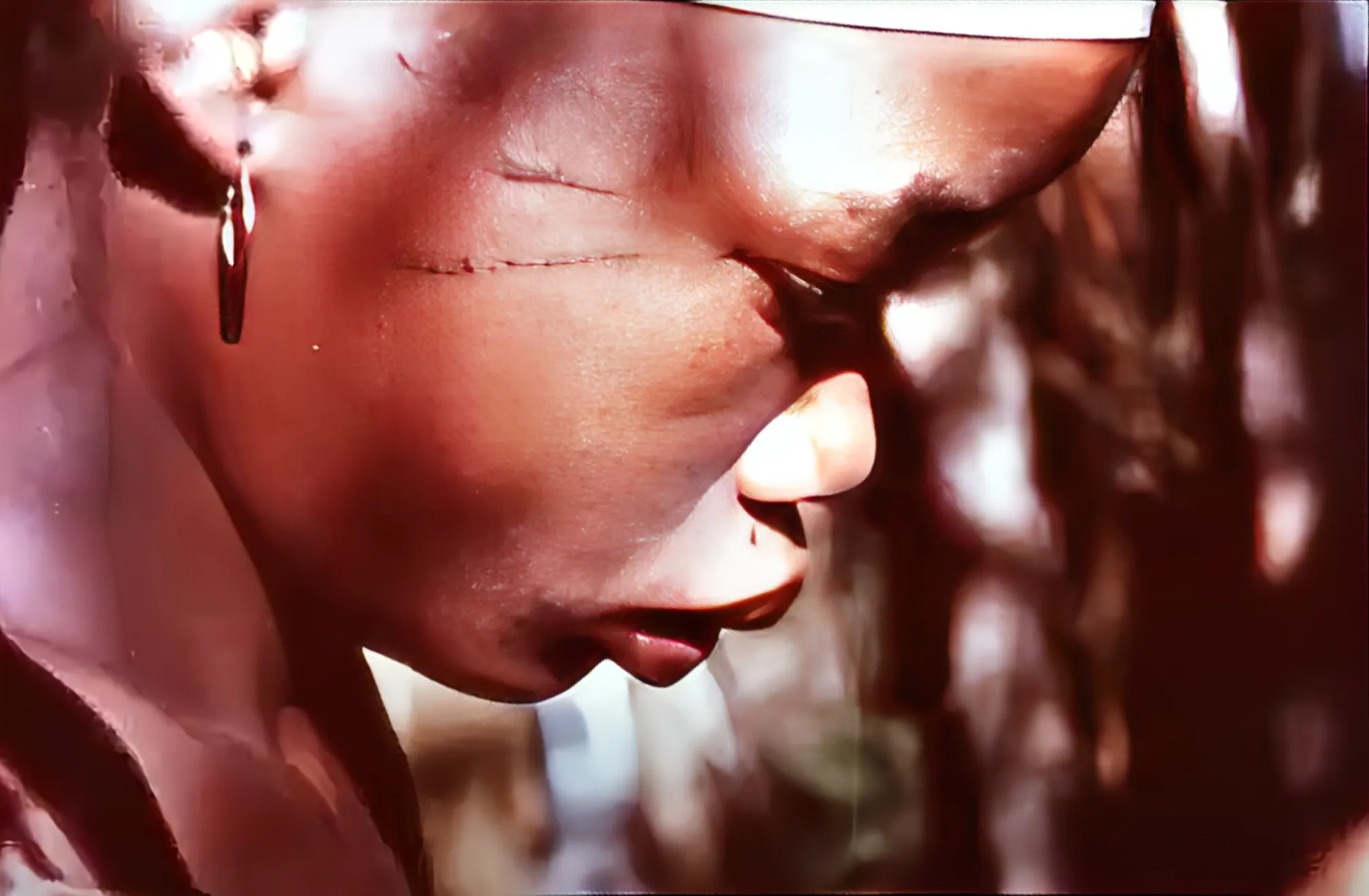 Documentary Educational Resources, Nǃai, the Story of a ǃKung Woman (1980)
Documentary Educational Resources, Nǃai, the Story of a ǃKung Woman (1980)
What happens next?
After the animal is brought back to the settlement, and credit is given for the kill, the animal is butchered and the meat is distributed by the village elders.
Since the !Kung are big on community well-being, leftover meat, or any kill that is too large to move, will then be given to neighboring tribes.
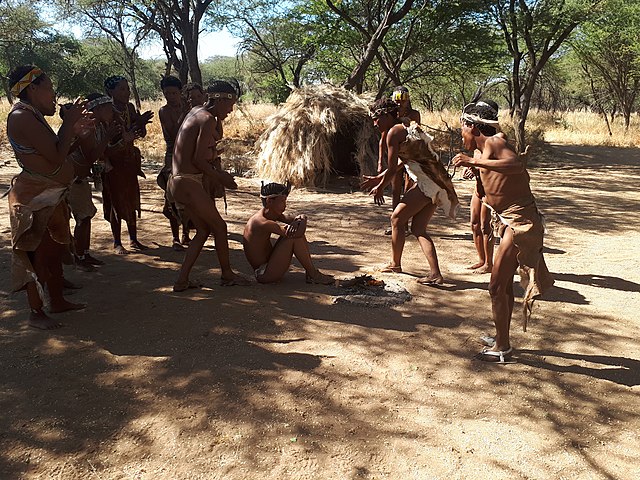 AnandievanZyl, Wikimedia Commons
AnandievanZyl, Wikimedia Commons
What is their social structure like?
Unlike many other hunter-gatherer tribes, the !Kung do not have a chief or headman in a position of power over the other members. They practice a more egalitarian social structure, where all members are of equal status.
They are not against leadership, but they are also not dependent on it. So, while they don’t technically have a leader, they do have someone who makes certain decisions.
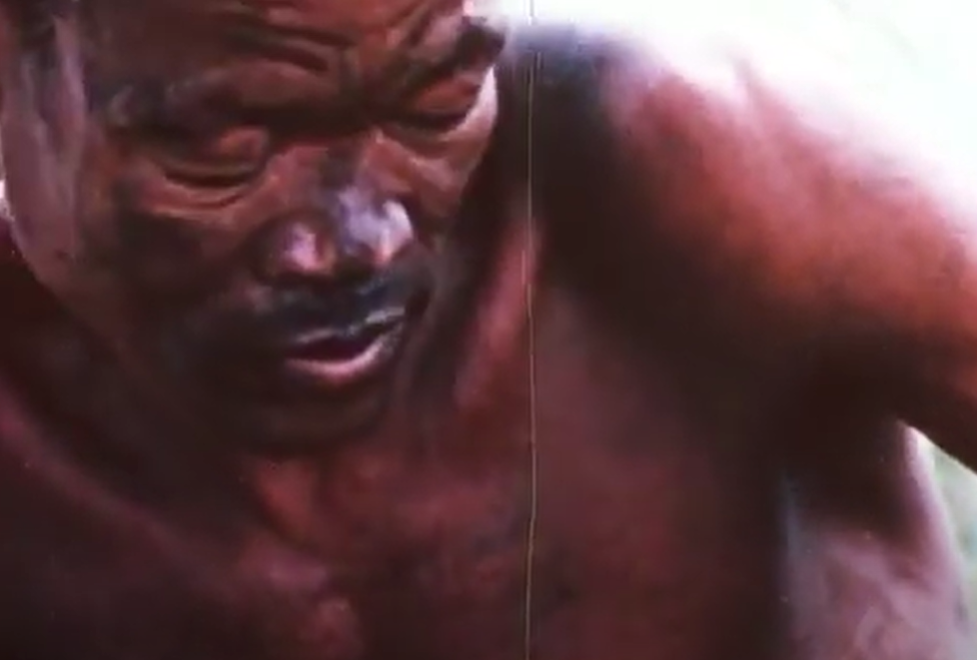 Documentary Educational Resources, Nǃai, the Story of a ǃKung Woman (1980)
Documentary Educational Resources, Nǃai, the Story of a ǃKung Woman (1980)
What is the “chieftain”?
Not all !Kung bands have a chieftain as it is somewhat of a complicated process to gain that position. A chieftain does not have more “power” than others, instead they assume certain responsibilities, such as dividing meat.
What are their kinship principles?
Kinship is one of the central organizing principles for societies like the ǃKung. Their kinship principles are broken down into three different sets: Kinship I, Kinship II, and Kinship III or wi.
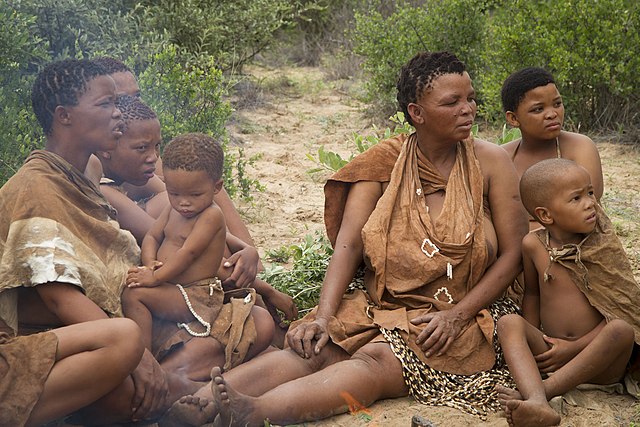 Mopane Game Safaris, Wikimedia Commons
Mopane Game Safaris, Wikimedia Commons
Kinship I and II
Kinship I follows conventional kin terms (father, mother, brother, sister) and is based on genealogical position.
Kinship II applies to name relationships, meaning that people who share the same name (ǃkunǃa) are treated as though they are kin of the same family and are assigned the same kinship term.
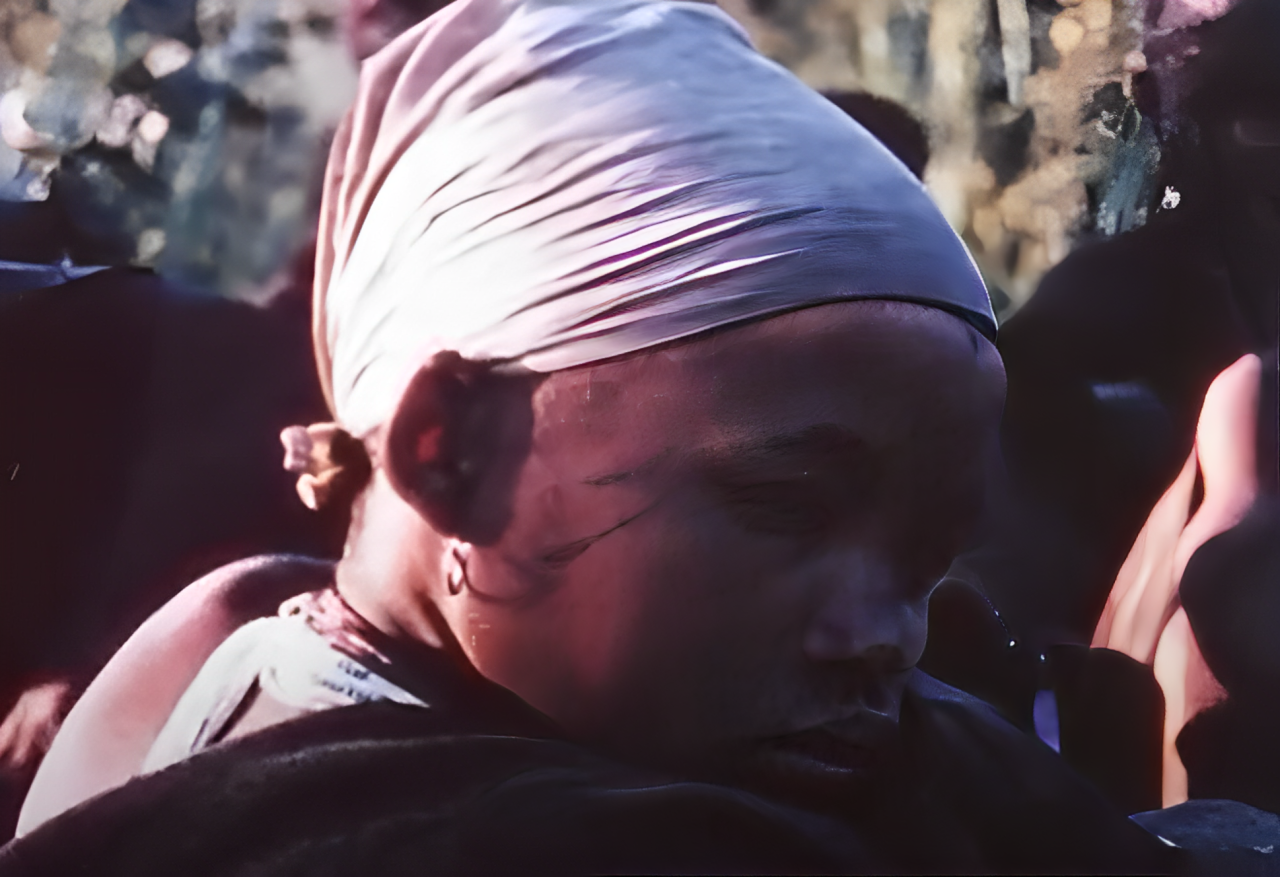 Documentary Educational Resources, Nǃai, the Story of a ǃKung Woman (1980)
Documentary Educational Resources, Nǃai, the Story of a ǃKung Woman (1980)
Kinship III or wi
Kinship III or wi has to do with the principles of relative age status. In situations where there are two people trying to decide what kin terms to use, the older person makes the ultimate decision.
This is especially important in cultures like the ǃKung as there are not many status distinctions.
What are their naming customs?
There are a limited number of ǃKung names.
!Kung names are also strictly gendered meaning that men and women cannot share the same name.
Names are passed down from ancestors according to a strict set of rules, though parents are never allowed to name their children after themselves.
There are also generational terms.
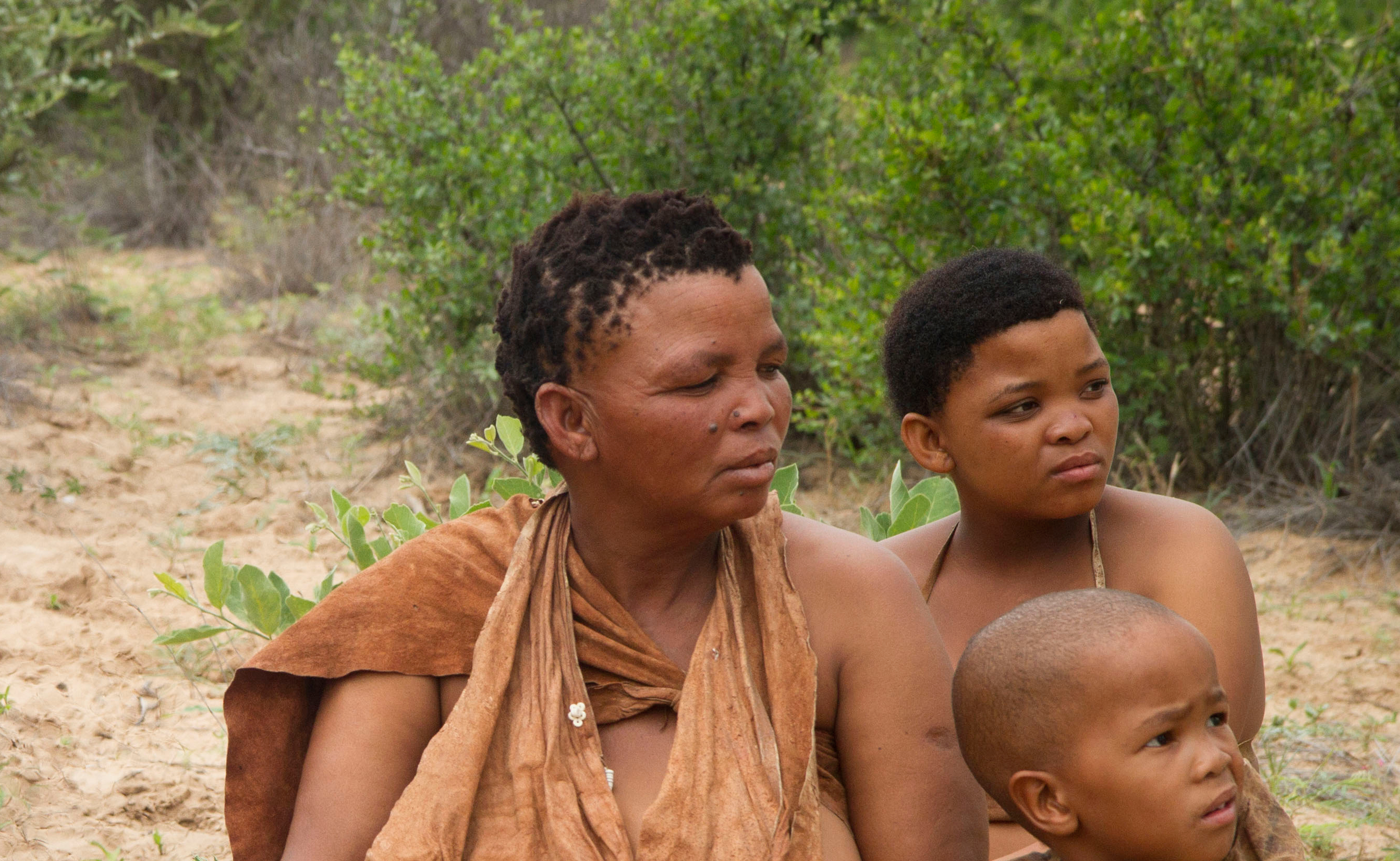 Mopane Game Safaris, CC BY-SA 4.0 , Wikimedia Commons
Mopane Game Safaris, CC BY-SA 4.0 , Wikimedia Commons
Alternating Generations Principle
There is a principle of alternating generations in terms of "joking" (k”ai) and "avoidance" (kwa) relations.
One's own generation and the second generation up and down are considered "joking" relations and are treated with relaxed affection.
The first generations above and below one are "avoidance" relations and are treated in a respectful and reserved manner—basically avoiding them.
Every member of ǃKung society fits into one of these categories, there are no neutral people.
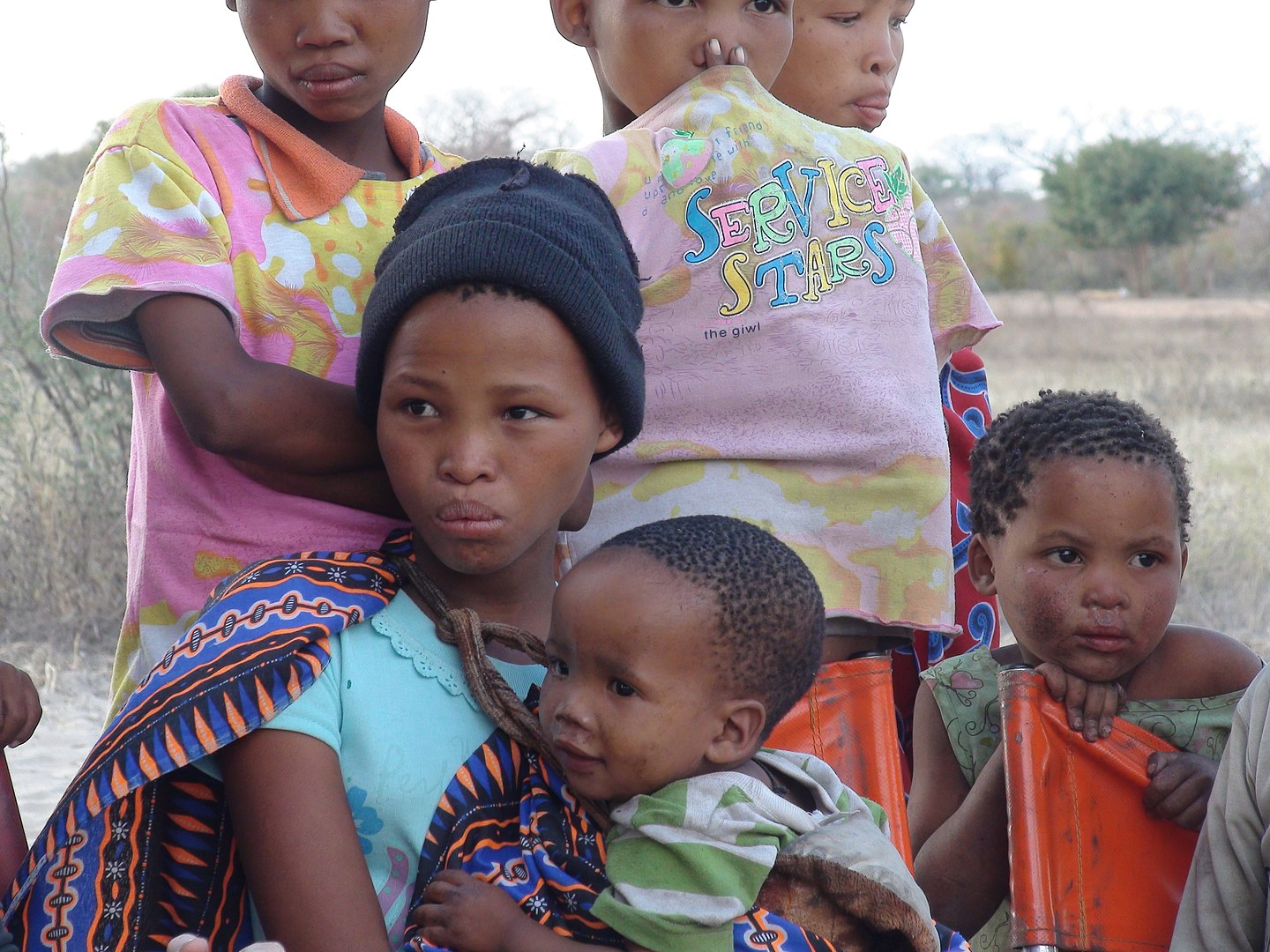 Nicolas M. Perrault, Wikimedia Commons
Nicolas M. Perrault, Wikimedia Commons
What is marriage like?
Marriage is the major focus of alliance formation between groups of ǃKung. Every first marriage is arranged, and most marriages are monogamous.
The culture of the ǃKung is "being directed at marriage itself, rather than at a specific man." Even though it does not matter who the man is, the woman's family is looking for a specific type of man.
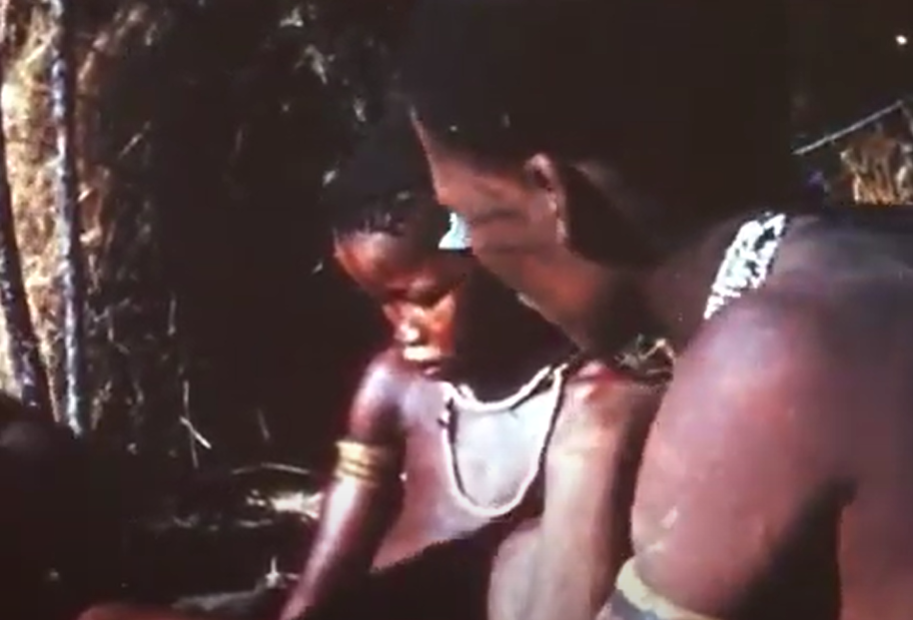 Documentary Educational Resources, Nǃai, the Story of a ǃKung Woman (1980)
Documentary Educational Resources, Nǃai, the Story of a ǃKung Woman (1980)
How is the man chosen?
The man chosen should not be too much older than the woman, and should preferably be unmarried rather than divorced. He should also be able to hunt, and willing to take on the responsibilities of the wife’s family.
As well, in many traditional !Kung marriages, the husband and wife are cousins.
What are the husband’s responsibilities in a marriage?
A man must be willing to take on the responsibilities of the wife’s family upon marriage because in their culture, a woman's family depends heavily on her husband's family, particularly through trade, when there are times of scarcity.
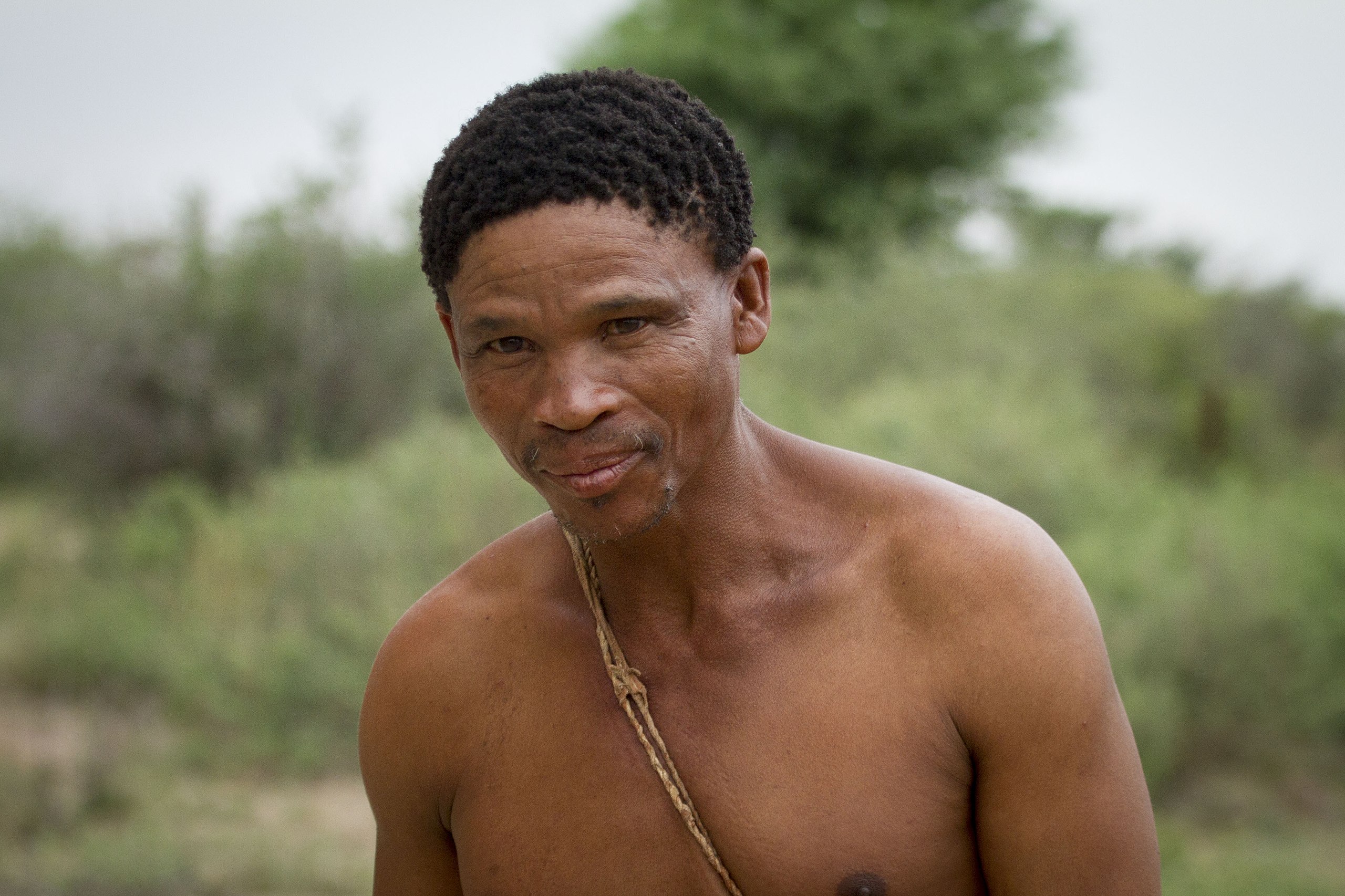 Mopane Game Safaris, CC BY-SA 4.0 , Wikimedia Commons
Mopane Game Safaris, CC BY-SA 4.0 , Wikimedia Commons
What age do they get married?
As soon as a woman’s body starts to develop, she is considered ready for marriage—which is typically during the early teen years.
The men are usually in their twenties during their first marriage.
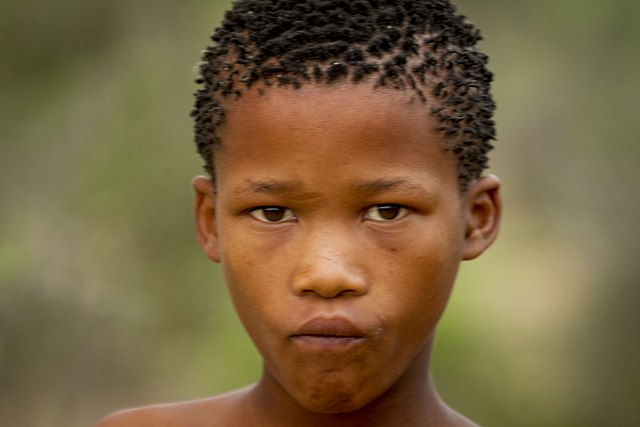 Mopane Game Safaris, Wikimedia Commons
Mopane Game Safaris, Wikimedia Commons
What is the wedding ceremony like?
On the marriage day, the tradition is the "marriage-by-capture" ceremony in which the bride is forcibly removed from her hut and presented to her groom.
During the ceremony, the bride has her head covered and is carried and then laid down in the hut while the groom is led to the hut and sits beside the door.
The couple stay respectfully apart from each other while an elder performs the ceremony—and also during the “reception.”
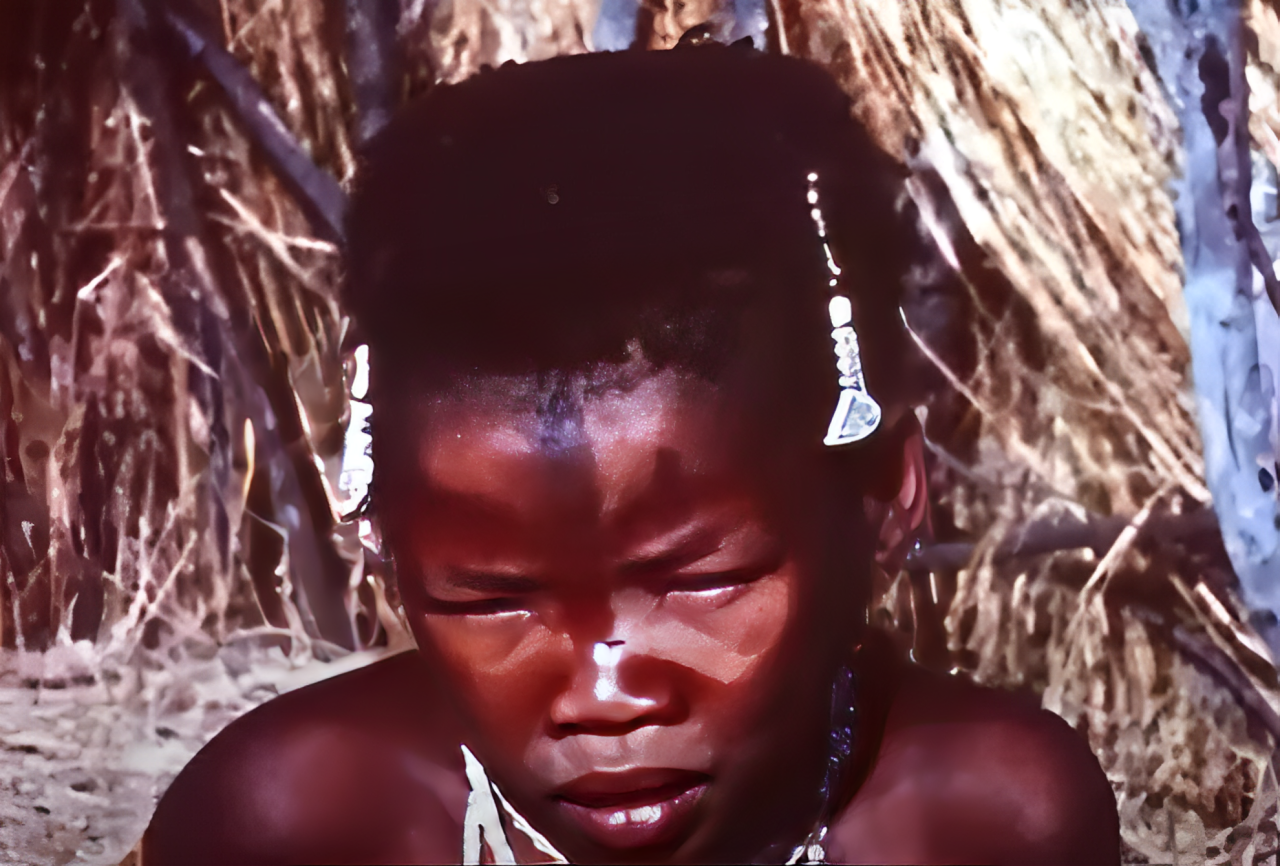 Documentary Educational Resources, Nǃai, the Story of a ǃKung Woman (1980)
Documentary Educational Resources, Nǃai, the Story of a ǃKung Woman (1980)
What is the wedding reception like?
The bride and groom do not traditionally attend the wedding festivities for their own wedding. The party is meant for the families.
After the party is over, the bride and groom spend the night together and the next morning they are ceremonially rubbed with oil by the husband's mother.
What is newlywed life like?
Traditionally, newlyweds live in the same village as the wife’s family so she has family support during her transition into marriage.
Often, a young wife will return to her parent’s house to sleep until she becomes comfortable with her husband.
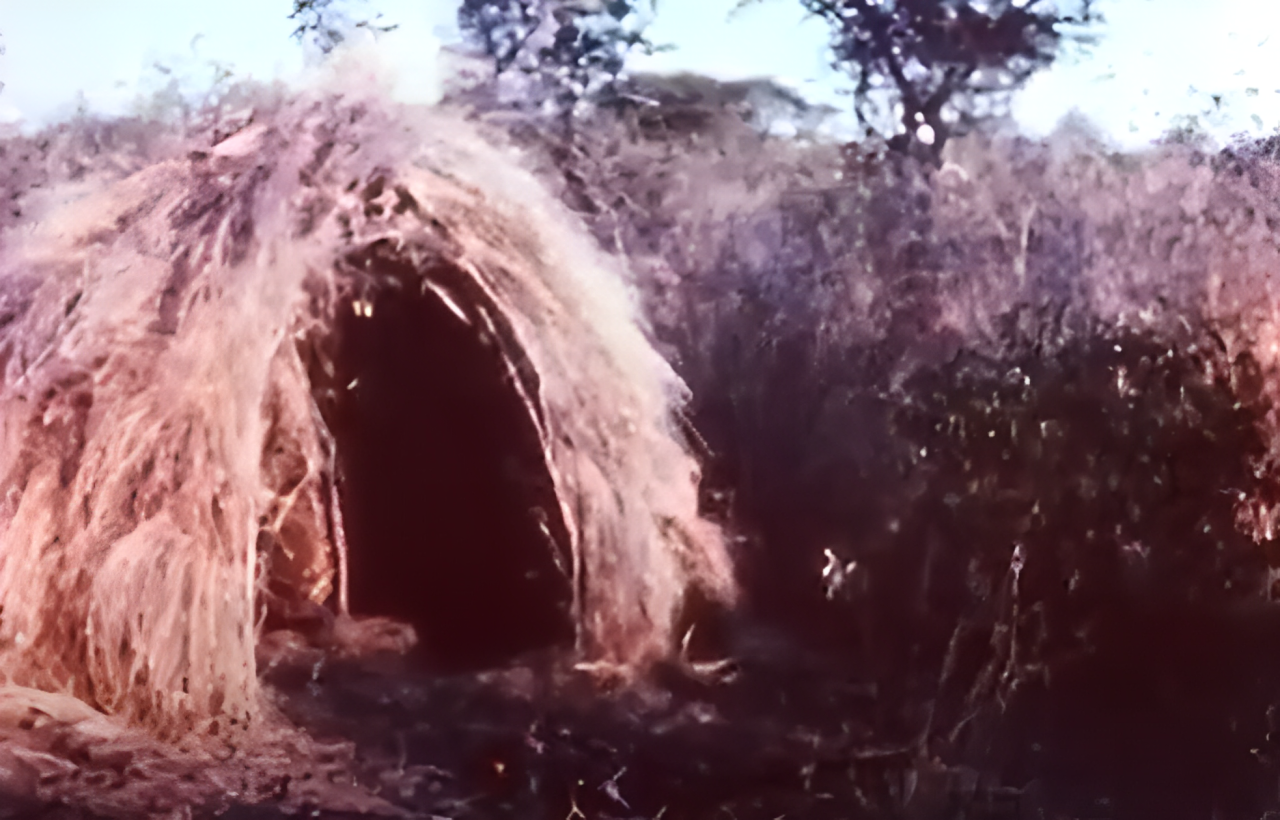 Documentary Educational Resources, Nǃai, the Story of a ǃKung Woman (1980)
Documentary Educational Resources, Nǃai, the Story of a ǃKung Woman (1980)
Is there a dowry?
The !Kung do have a form of bride wealth. During the honeymoon stage, the husband will hunt for his wife’s family, taking on the responsibilities of his bride’s father, proving that he is deserving of their daughter.
Where do they live after marriage?
Once a couple becomes comfortable enough to live together, they can choose either partner’s side of the family, settling with whichever is most beneficial at the time.
Is divorce allowed?
Yes. In fact, if a man or woman never becomes comfortable with their new spouse, separation is acceptable.
Divorce remains possible throughout marriage. While extramarital sex is not condoned, it is equally acceptable among both men and women.
What if a woman does not like the man her parents chose for her?
Believe it or not, there is a simple—yet dramatic—way to handle this.
Girls who are displeased with their parents' selection may violently protest against the marriage by kicking and screaming and running away at the end of the ceremony.
After she has run away, this may result in the dissolution of the arrangement.
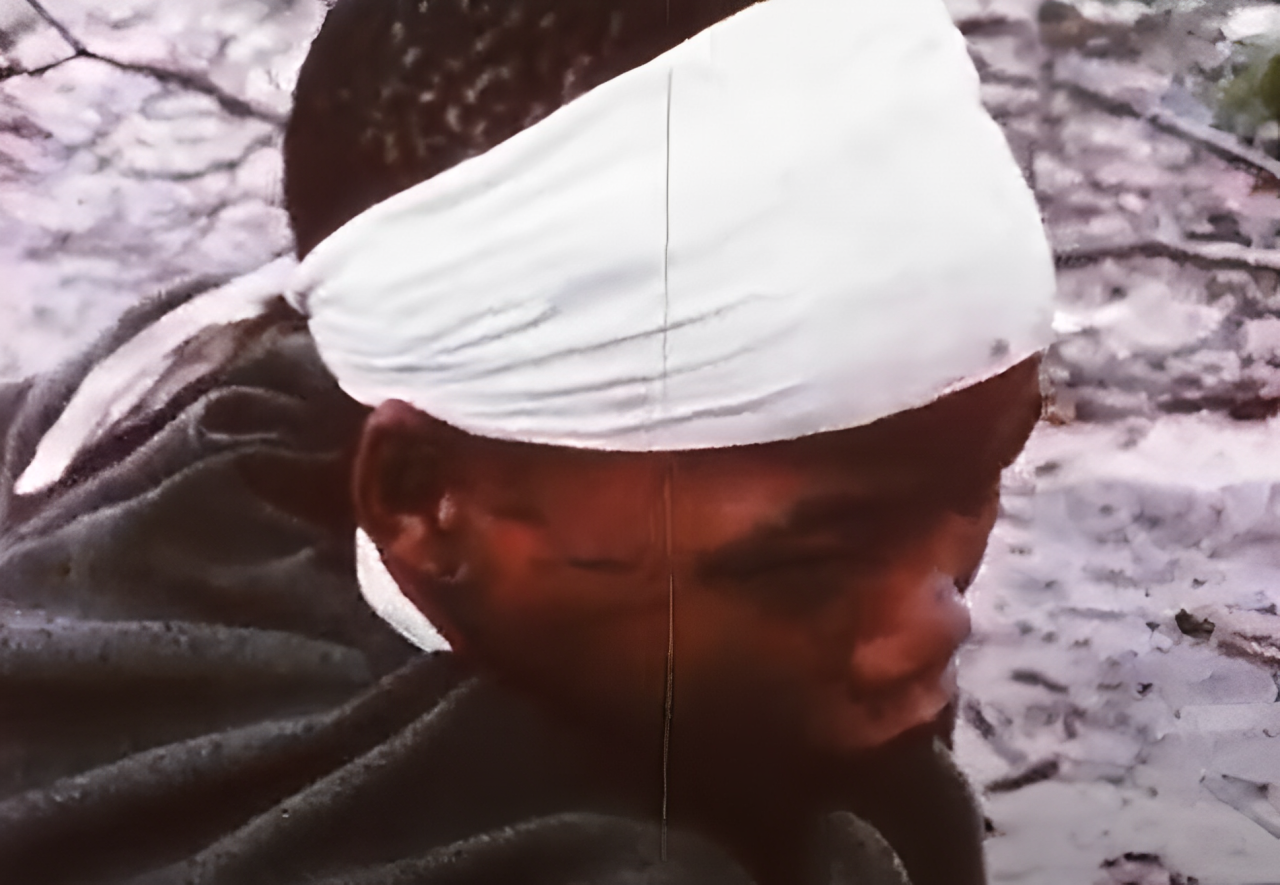 Documentary Educational Resources, Nǃai, the Story of a ǃKung Woman (1980)
Documentary Educational Resources, Nǃai, the Story of a ǃKung Woman (1980)
How often does this happen?
Apparently, half of all first marriages end in divorce. This is likely because the first marriages are always arranged, with little say from either bride or groom.
The divorce process is simple, though.
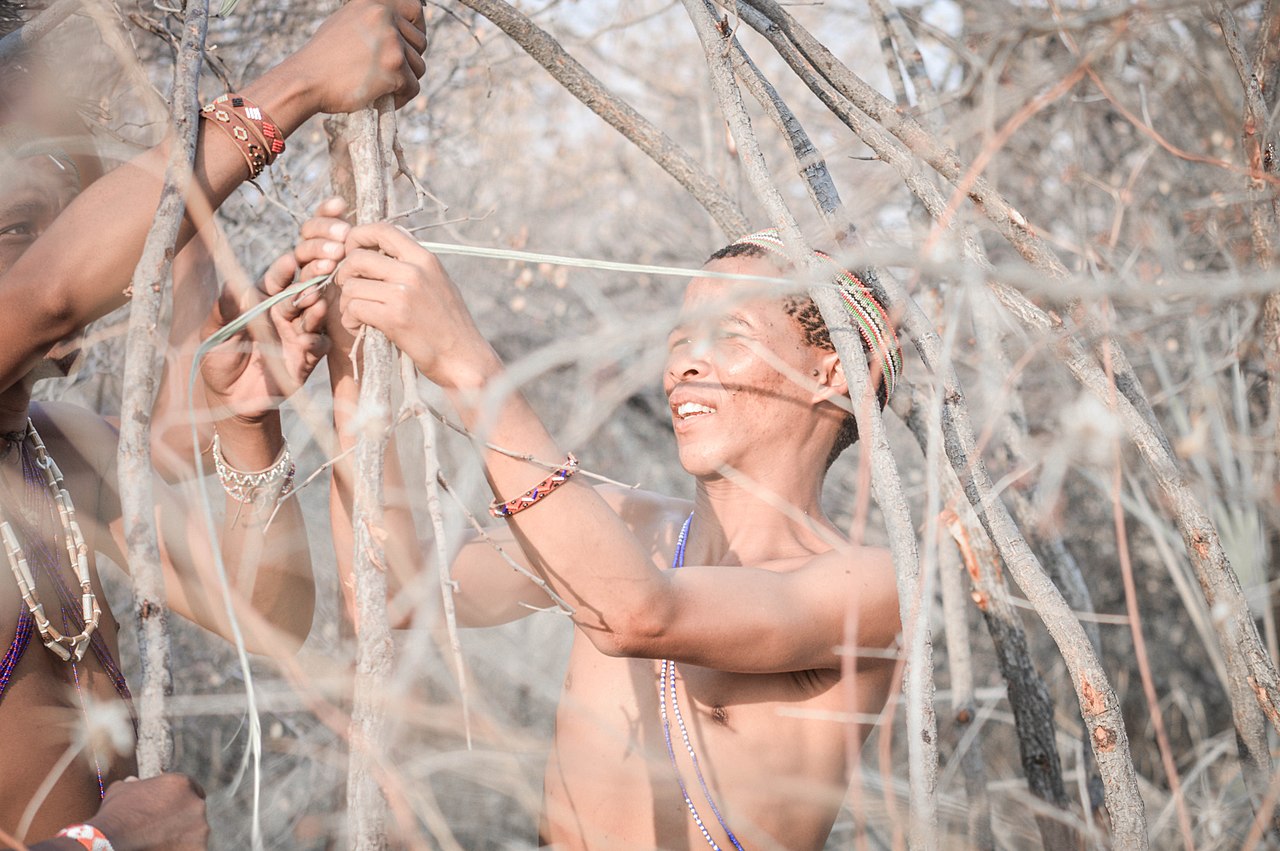 Andy Maano, CC BY-SA 4.0 , Wikimedia Commons
Andy Maano, CC BY-SA 4.0 , Wikimedia Commons
What is the divorce process?
Traditionally, when a divorce is proposed, everyone in the village offers their opinion on whether or not the marriage should continue.
After a consensus is reached—usually everyone just agrees to let them go their separate ways—the couple simply returns to their family’s huts and are no longer considered married.
What happens after the divorce?
After a divorce, the couple usually stay friendly and live close to each other, especially if they have children.
A divorced woman is then free to marry someone of her own choosing, or she can choose to stay single and live on her own.
In fact, this is the only way a woman is allowed to live on her own. Which may explain why half of all first (arranged) marriages end in divorce.
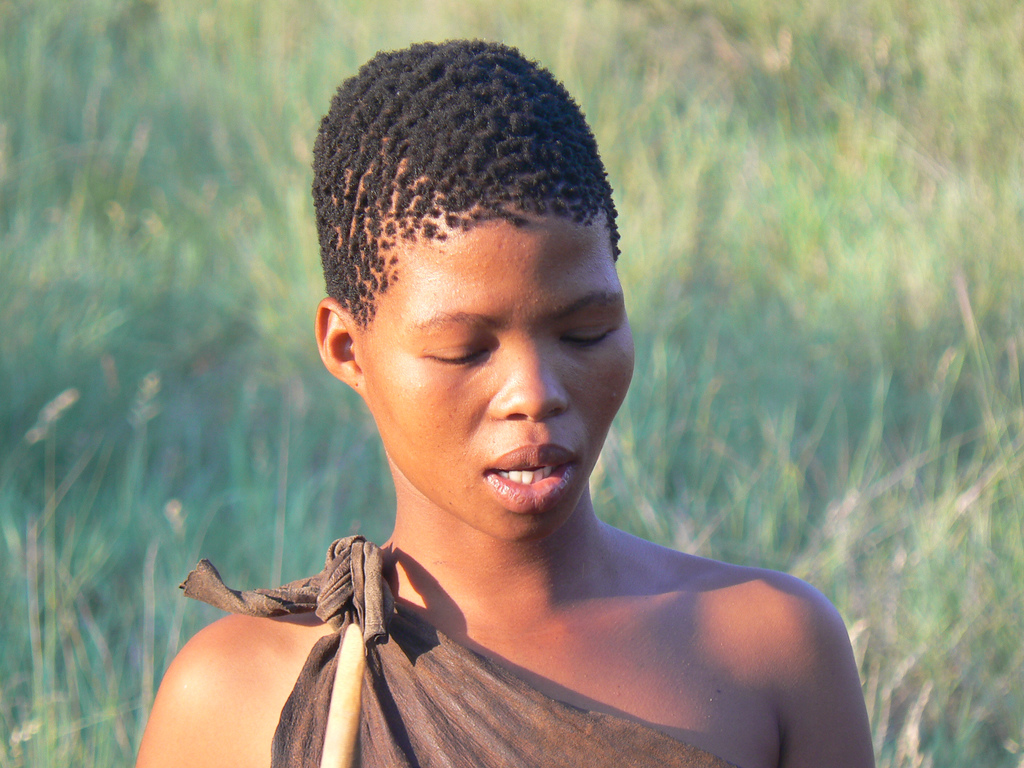 Lisa Gray, CC BY 2.0, Wikimedia Commons
Lisa Gray, CC BY 2.0, Wikimedia Commons
What are the typical gender roles of !Kung women?
Traditionally, !Kung women generally collect plant foods and water, prepare food, and take care of children.
Most of their responsibilities are done close to home so women can socialize and help each other. !Kung women enjoy each other’s company and like to socialize a lot.
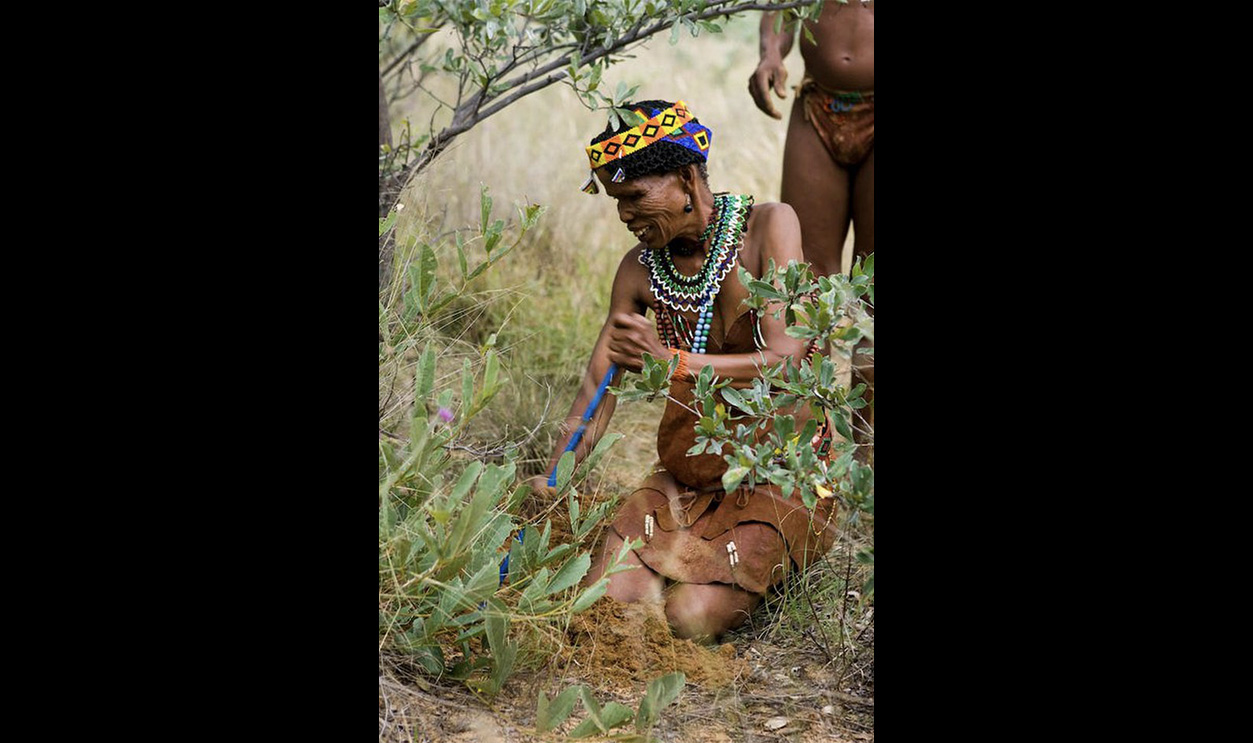 Alwynvanzyl, Wikimedia commons
Alwynvanzyl, Wikimedia commons
What are the typical gender roles of !Kung men?
!Kung men are mostly responsibly for hunting and building. However, they also partake in food preparation and caring for children, as well as many household duties.
Aside from hunting, most village responsibilities are done by everyone equally.
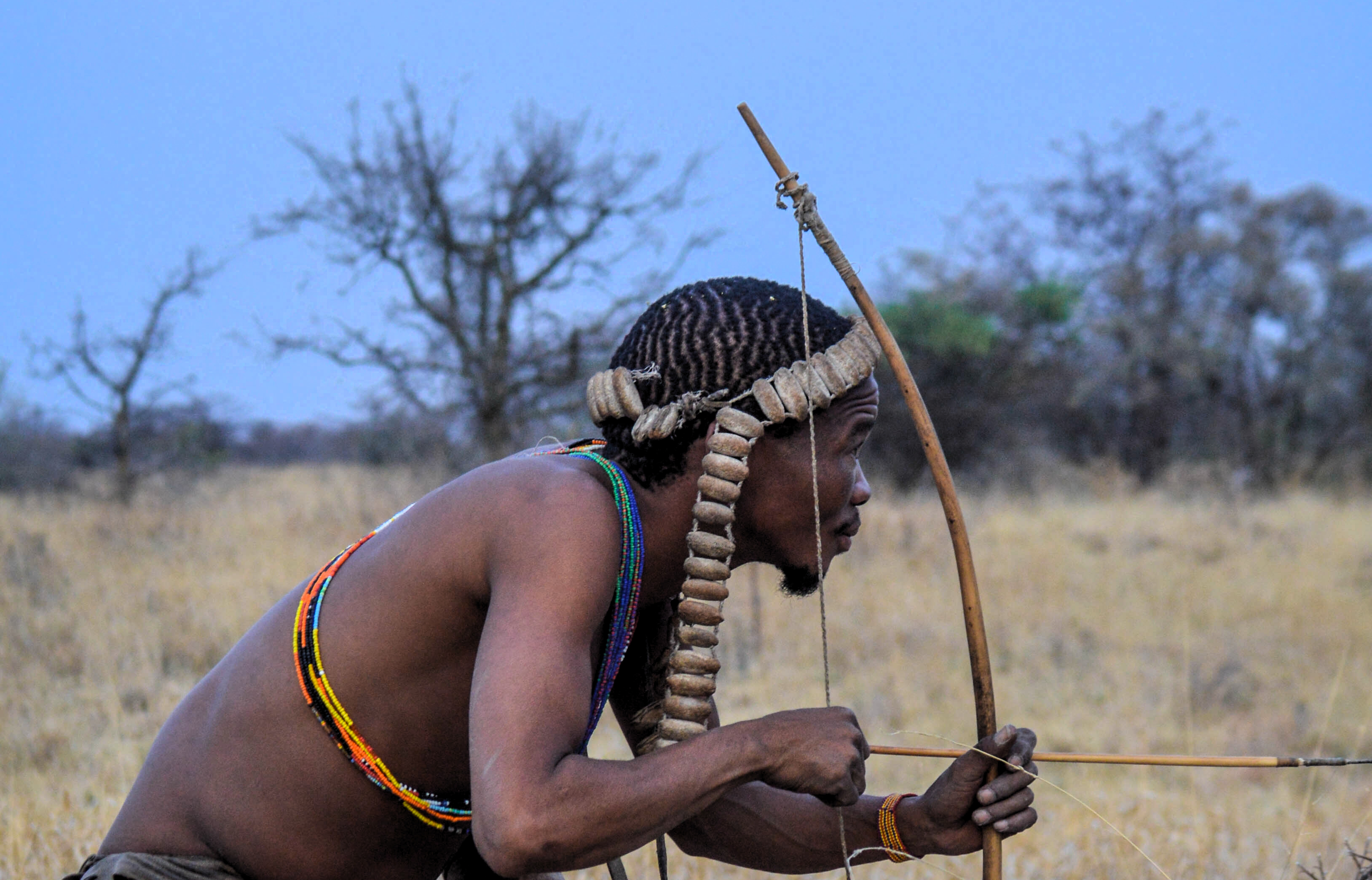 Andy Maano, CC BY-SA 4.0 , Wikimedia Commons
Andy Maano, CC BY-SA 4.0 , Wikimedia Commons
What is childbirth like?
!Kung women typically have children when they are between the ages of 19-35.
They give birth unassisted, walking away from the village camp as far as a mile during labor and bearing the child alone, delivering it into a small leaf-lined hole dug into the warm sand.
After the placenta is delivered, it is kept attached to the baby and a larger leaf is placed over both baby and placenta. The mother then walks away to alert the elder women of the completed birth, and they join her for a celebration.
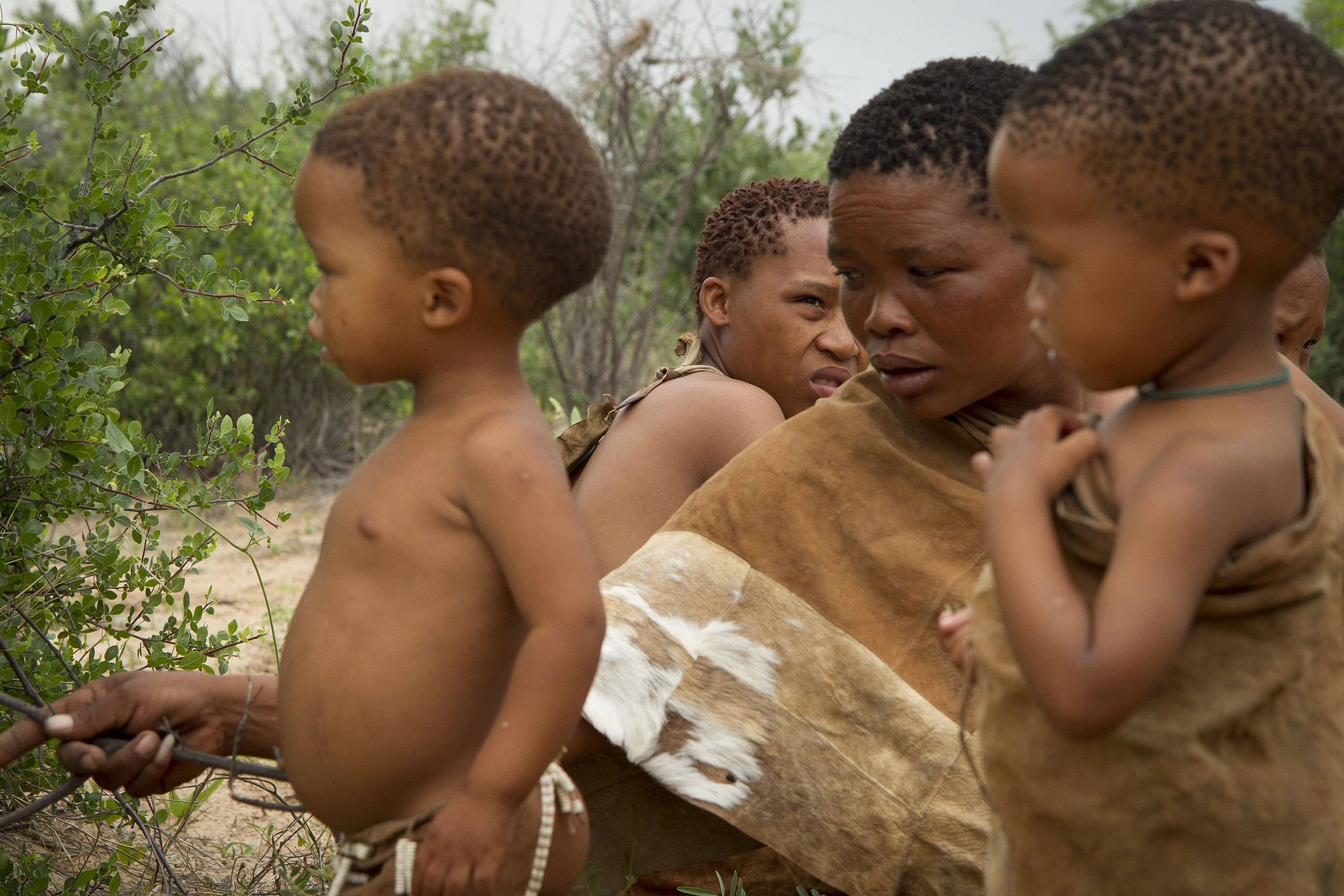 Mopane Game Safaris, CC BY-SA 4.0, Wikimedia Commons
Mopane Game Safaris, CC BY-SA 4.0, Wikimedia Commons
What if there was a birth complication?
Generally, most !Kung births happen without complications. But, if an elder !Kung woman notices that a birthing mother has been gone longer than expected, she will go and find her and assist however she can.
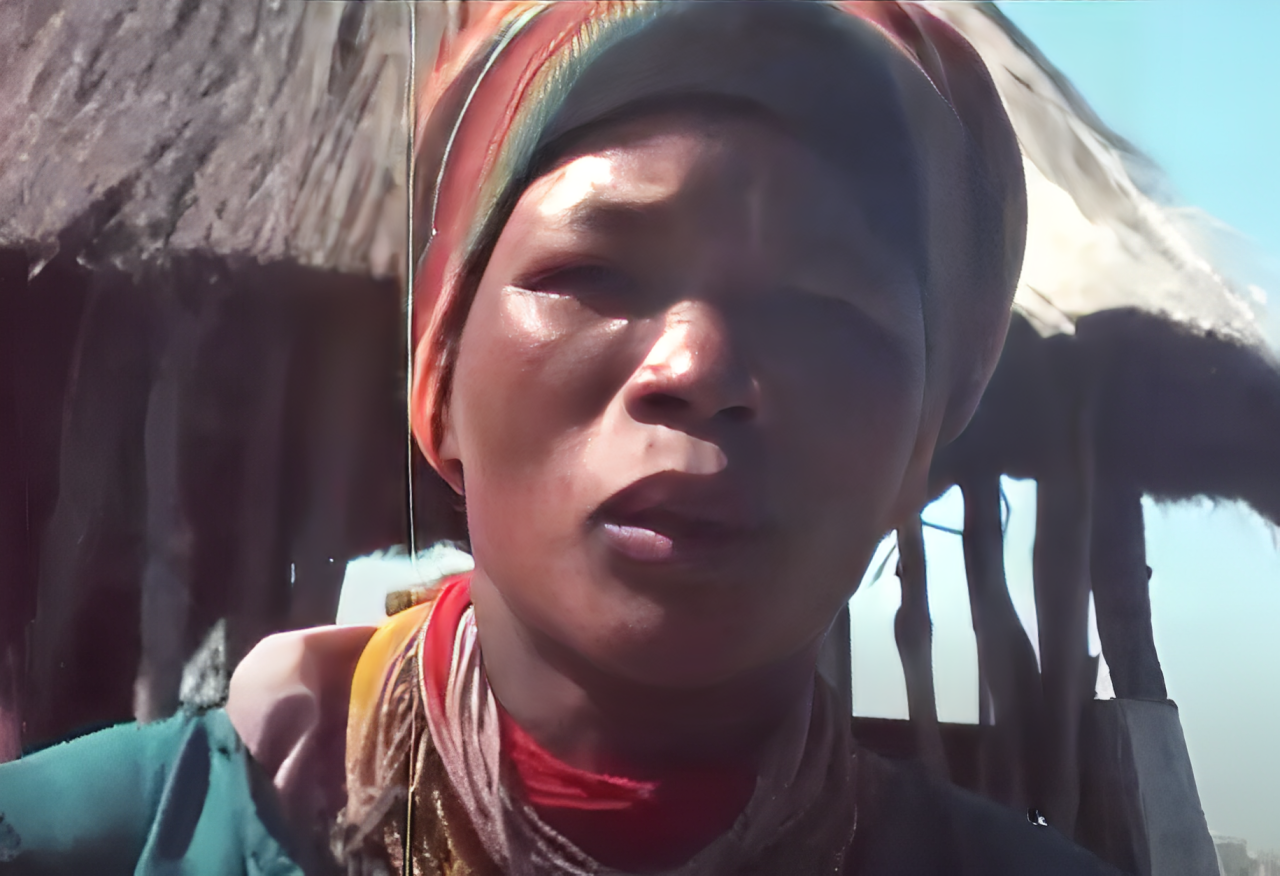 Documentary Educational Resources, Nǃai, the Story of a ǃKung Woman (1980)
Documentary Educational Resources, Nǃai, the Story of a ǃKung Woman (1980)
How are children planned?
Time between births is traditionally 3-5 years. This is also about the length of time a mother will nurse her baby. Usually, nursing stops when she becomes pregnant with her next child.
This is specifically planned as it is easier to travel with less infants to carry. This also helps with population control—which is something that was necessary due to limited resources.
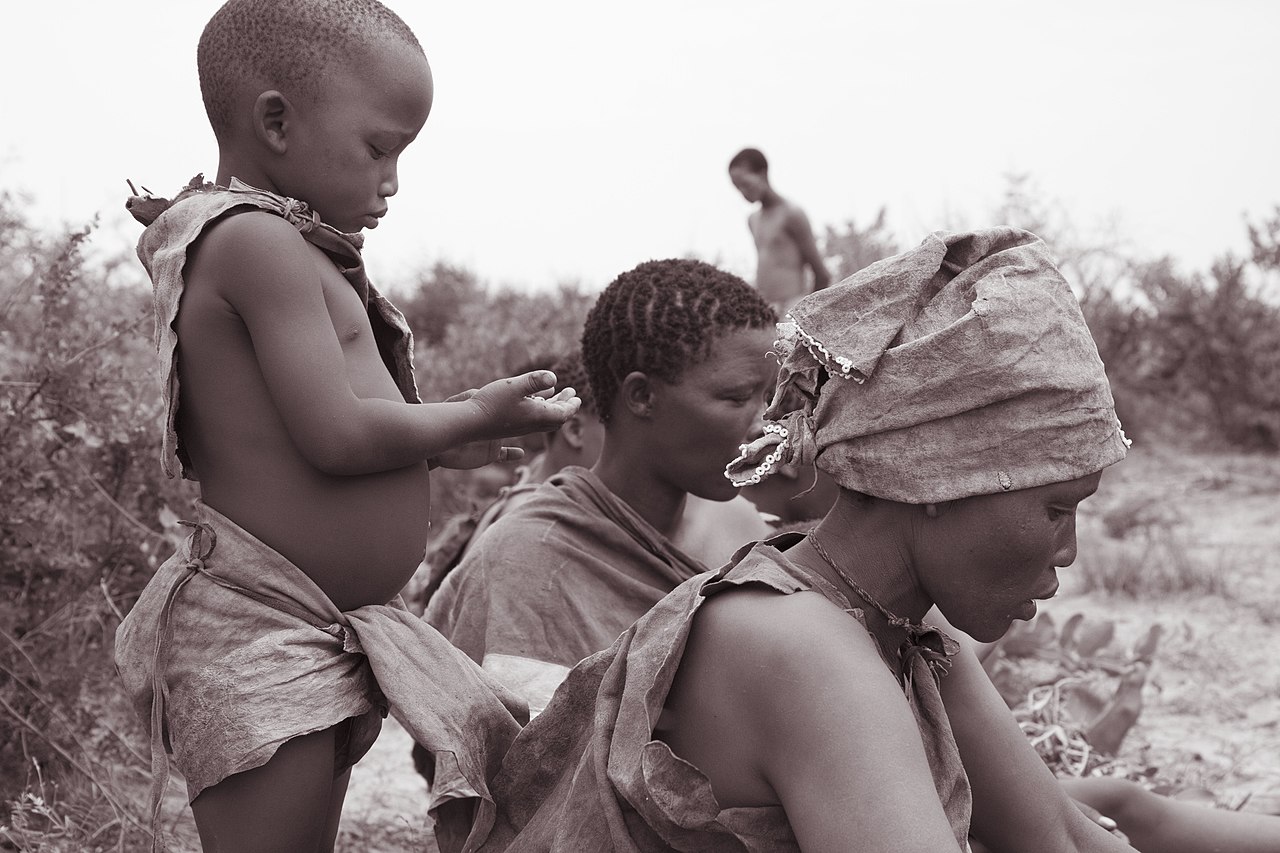 Mopane Game Safaris, CC BY-SA 4.0, Wikimedia Commons
Mopane Game Safaris, CC BY-SA 4.0, Wikimedia Commons
What happened when they did not have enough resources for the whole tribe?
Unfortunately, during times of deprivation, infanticide was practiced to preserve resources. Though it is said that this was often a last resort, and the mothers often offered to go without food before giving up their babies.
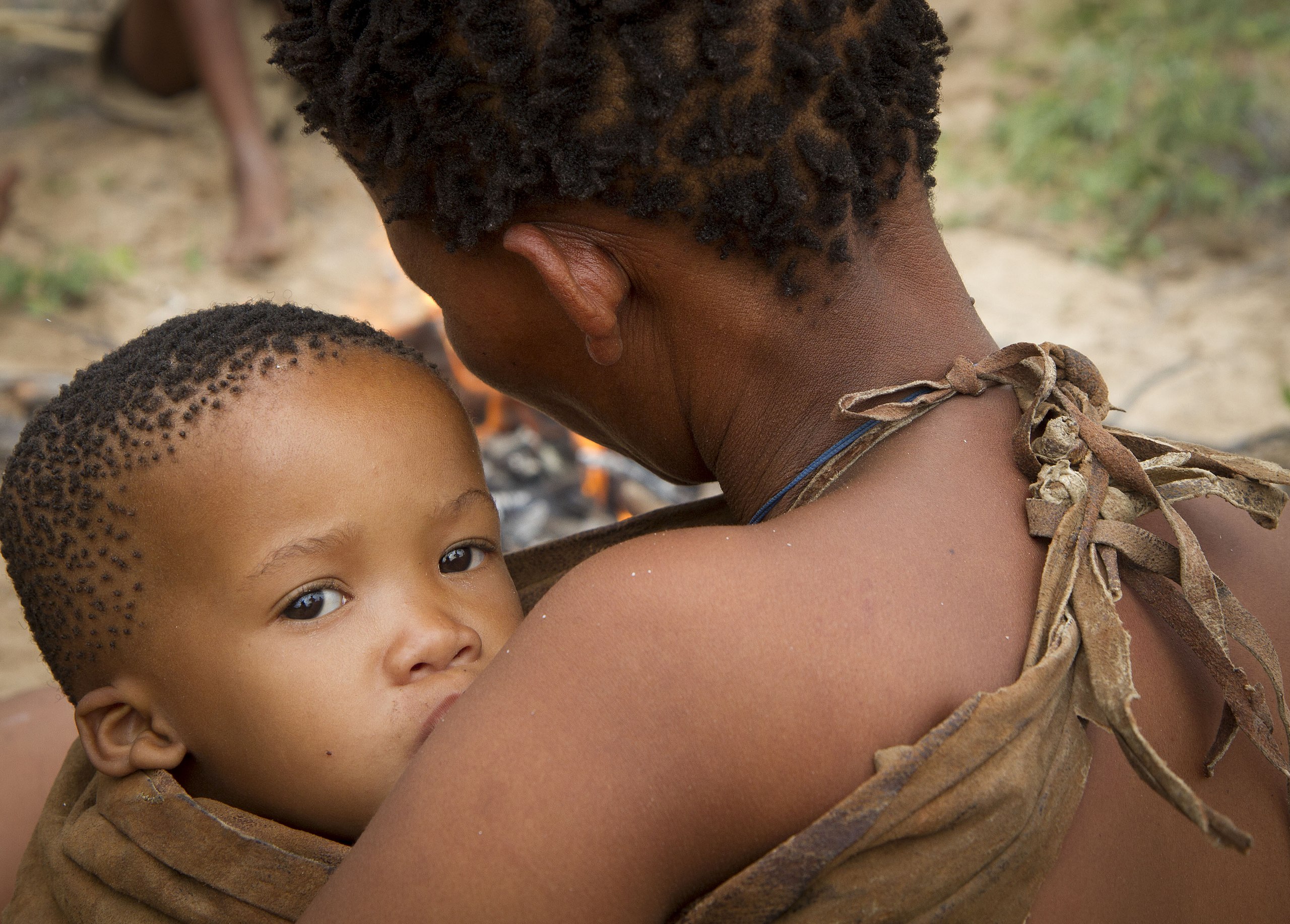 Mopane Game Safaris, CC BY-SA 4.0, Wikimedia Commons
Mopane Game Safaris, CC BY-SA 4.0, Wikimedia Commons
Do they practice birth control?
Not exactly. The !Kung do not use any sort of contraceptives and they also do not practice abstinence.
However, it is said that a higher body fat percentage increases chances of ovulation. So, when a mother is nursing her baby, her body fat percentage lowers and therefore she is less likely to become pregnant. If a woman does not want a baby, she will maintain a lower body weight.
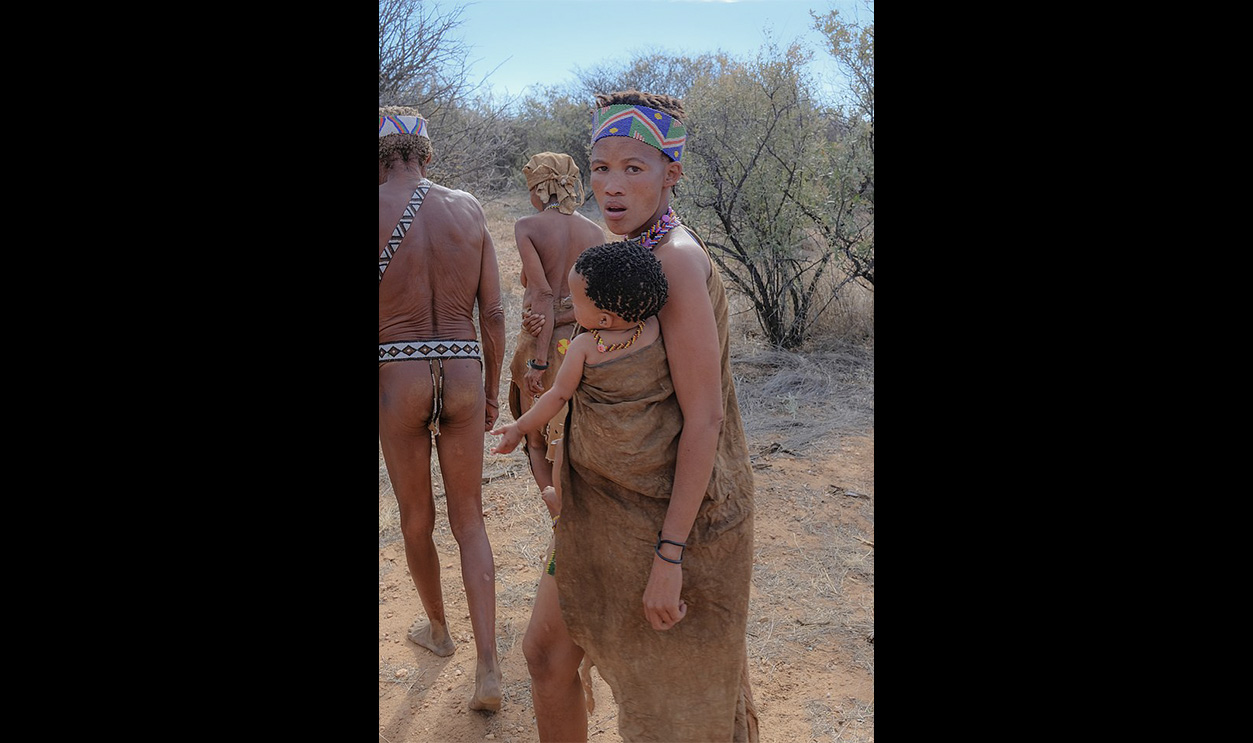 Julia Grahl, Wikimedia commons
Julia Grahl, Wikimedia commons
How are children raised?
Children are raised in village groups of other children of a wide age range. The settled !Kung group their children by gender and age, but the nomadic !Kung allow all children to group together in a non-competitive environment.
The mothers typically raise their children together with other mothers as a group, relying on each other for help and guidance.
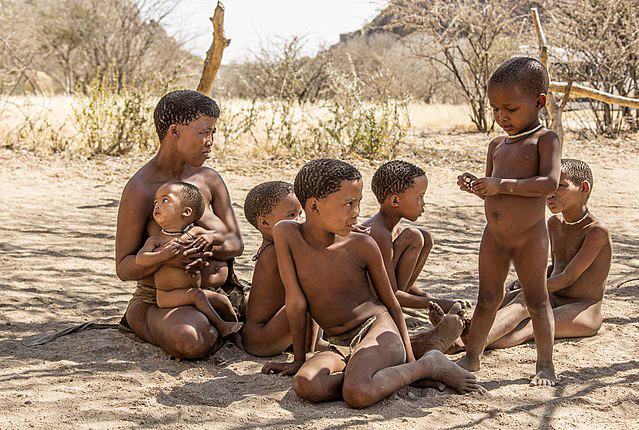 Rüdiger Wenzel, Wikimedia Commons
Rüdiger Wenzel, Wikimedia Commons
How do they take care of their health?
Traditional nomadic !Kung don’t have to worry as much about outside diseases as they are not often subjected to anything outside of their norm. This doesn’t mean they don’t get sick though.
What do they do when someone is sick?
Healing rituals are a primary part of the !Kung culture. In the ǃKung state of mind, having health is equivalent to having social harmony, meaning that relationships within the group are stable and open between other people.
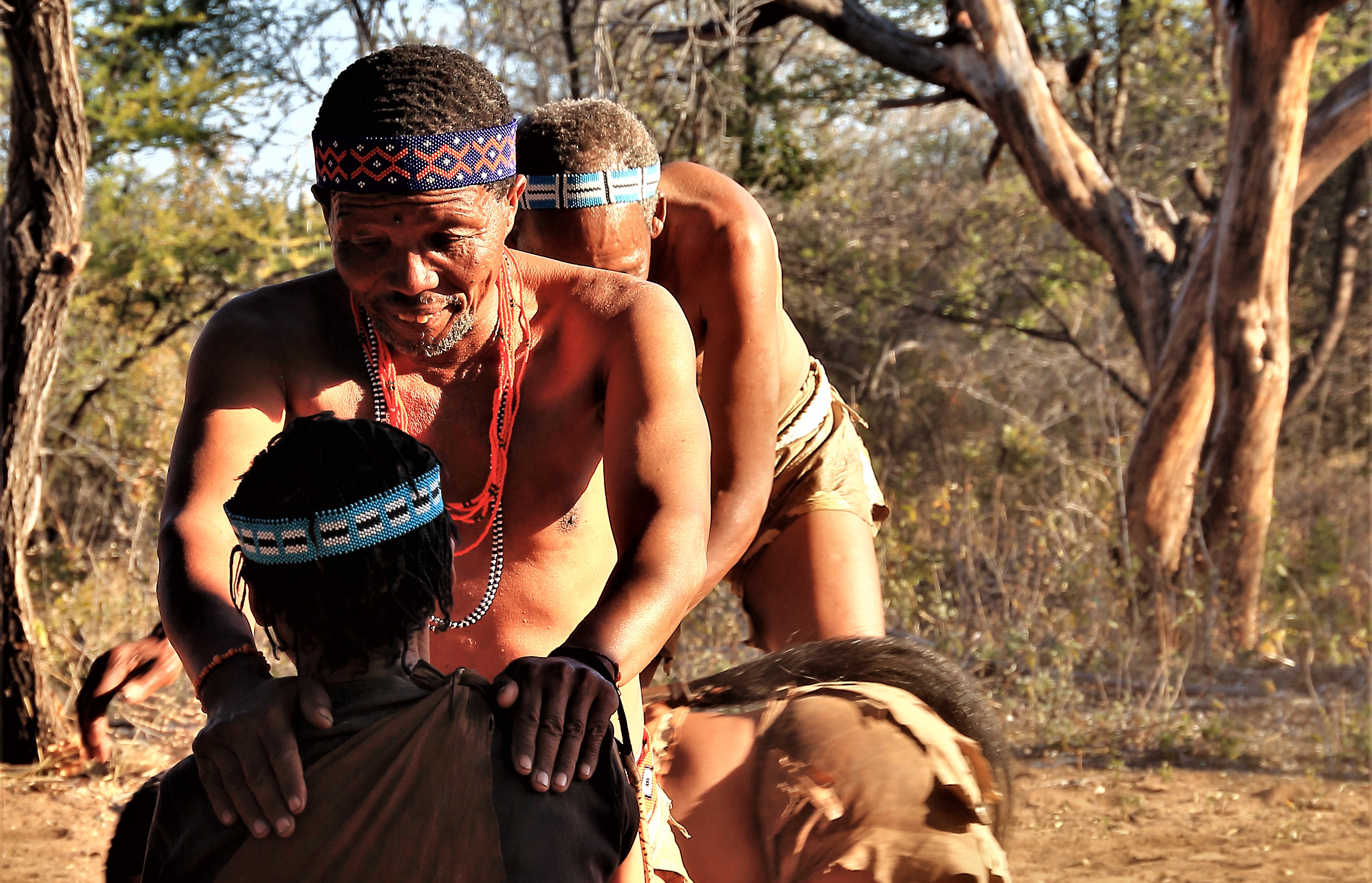 Kgara Kevin Rack, CC BY-SA 4.0, Wikimedia Commons
Kgara Kevin Rack, CC BY-SA 4.0, Wikimedia Commons
Do they have healers?
Yes. In fact, any !Kung can become a healer because it “is a status accessible to all," and it is a grand aspiration of many members because of its importance.
Nearly half the men and one-third of the women are acknowledged of having the power to heal—but with the responsibility comes great pain and hardship.
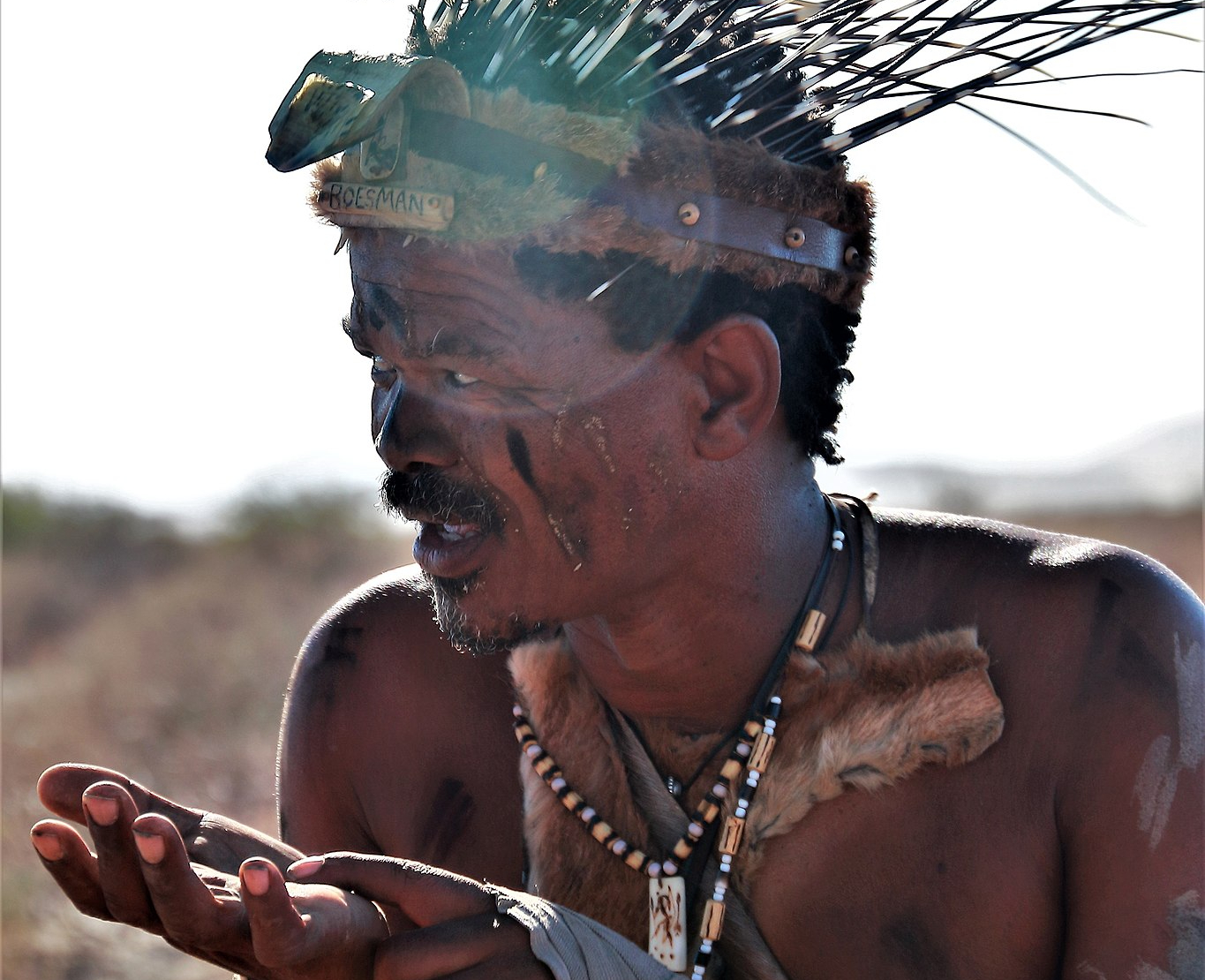 Kgara Kevin Rack, CC BY-SA 4.0 , Wikimedia Commons
Kgara Kevin Rack, CC BY-SA 4.0 , Wikimedia Commons
How does one become a healer?
To become a healer, candidates must become an apprentice and learn from older healers. Their training includes the older healer having to "go into a trance” to teach the beginners, and then rubbing their own sweat onto the pupils' centers—their bellies, backs, foreheads, and spines.
This training often scares most candidates and they end up changing their minds.
What do they call their healing force?
Their powerful healing force is called nǀum. It is believed that this force resides in the bellies of the men and women who have completed the training and become a healer.
They heal others through a !kia dance that takes place during the night. The dance is said to “heat up” the healing powers within them so they can transfer it to the sick person.
But this is where the pain happens.
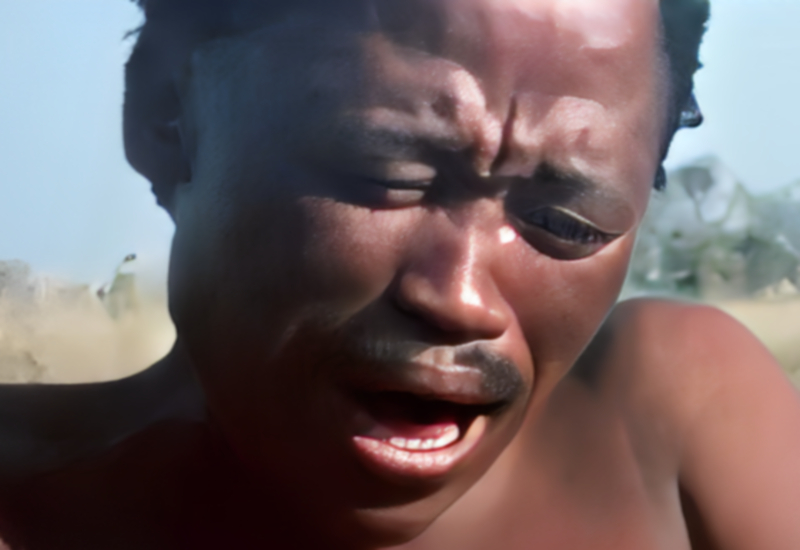 Documentary Educational Resources, Nǃai, the Story of a ǃKung Woman (1980)
Documentary Educational Resources, Nǃai, the Story of a ǃKung Woman (1980)
How is it painful?
When a healer is doing the dance, they are essentially inducing a “trance,” which is often accompanied by drinking a tea made of roots. This tea is said to make some healers vomit.
It is said that the drink makes them sick and also causes a burning feeling in their stomach. However, this is what they believe is the “powerful force” that heals.
How important are the healers?
The !Kung community places a lot of trust and dependence on the healers as they rely heavily on them for physical, psychological and spiritual healing.
The ǃKung have a saying: "Healing makes their hearts happy, and a happy heart is one that reflects a sense of community."
Because of their longing to keep the peace between people, their community is tranquil.
What are their beliefs?
The !Kung recognize a Supreme Being they call ǃXu, who is the Creator and Upholder of life. Like other African High Gods, he also punishes man using the weather (storms, droughts, etc.)
They also have animistic and animatistic beliefs, which means they believe in both personifications and impersonal forces.
Do they believe in spirits?
The !Kung have a strong believe in the existence of spirits of the dead (llgauwasi) who live immortally in the sky and can come to earth and interact with humans.
There is no particular connection to personal ancestors but the ǃKung fear the llgauwasi, pray to them for sympathy and mercy as well as call on them in anger.
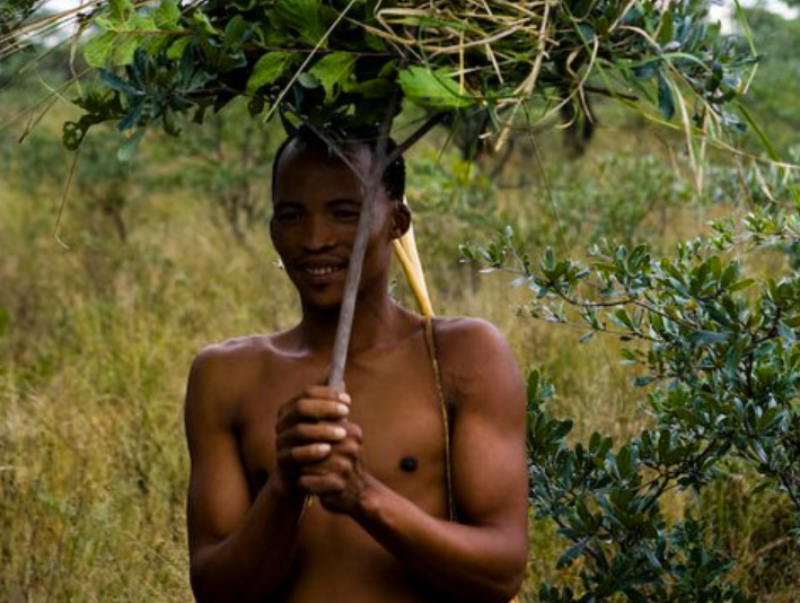 Alwynvanzyl, CC BY-SA 4.0 , Wikimedia Commons
Alwynvanzyl, CC BY-SA 4.0 , Wikimedia Commons
Why have most !Kung settled in permanent villages?
Many !Kung bands have become more and more colonized since the 1970s—however, not by choice.
Since the 1950s, cattle ranches have brought cows to the !Kung’s traditional lands, which then eat the sparse vegetation and dirty the water holes.
As a result, the !Kung have limited space left to find natural vegetation and hunt for small game.
Not only does this limit their food and water, it also introduced disease.
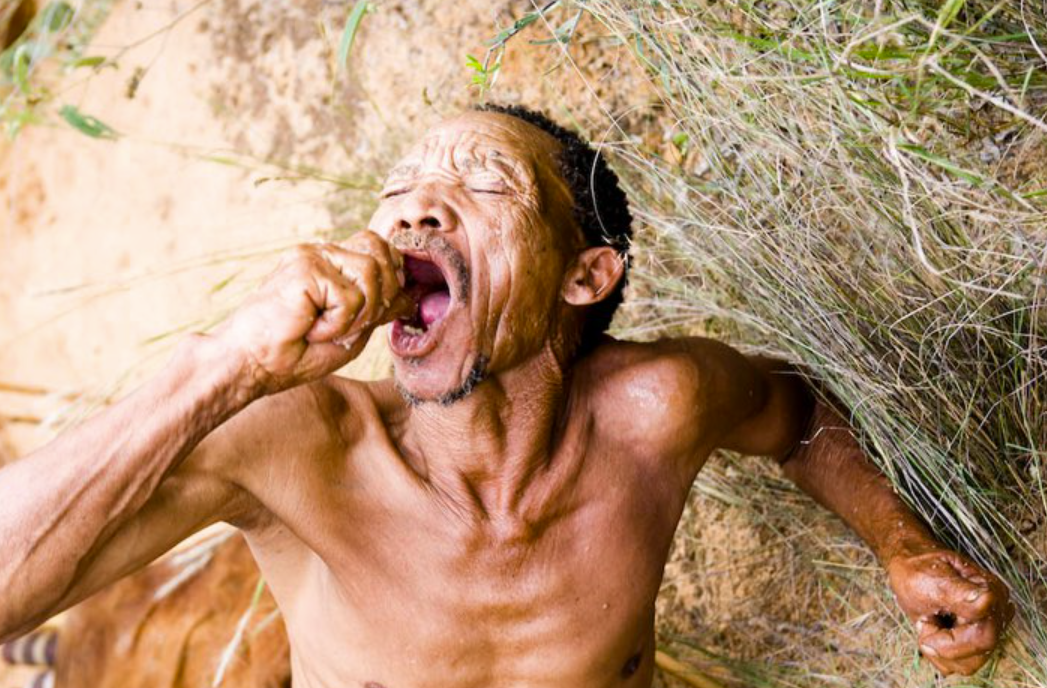 Alwynvanzyl, CC BY-SA 4.0, Wikimedia Commons
Alwynvanzyl, CC BY-SA 4.0, Wikimedia Commons
How did they set up permanent settlements?
The governments of Namibia and Botswana recognized the need for assistance and built permanent settlements with European style houses for the !Kung and other indigenous tribes of the area.
Farm labor jobs were offered to the !Kung men, introducing small wages and more trade options.
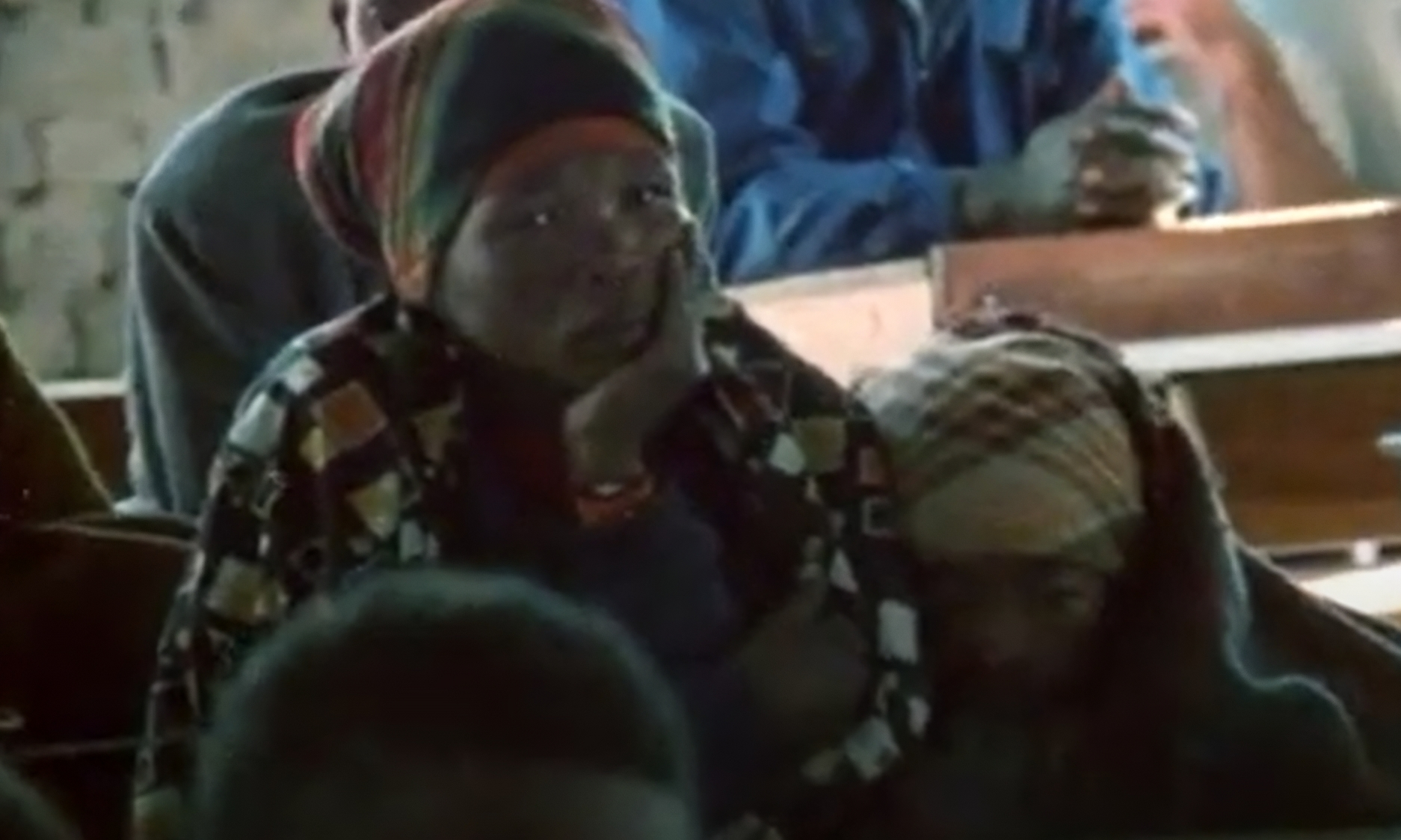 Documentary Educational Resources, Nǃai, the Story of a ǃKung Woman (1980)
Documentary Educational Resources, Nǃai, the Story of a ǃKung Woman (1980)
How did permanent settlements change their traditional lifestyle?
Aside from having permanent housing, the biggest change in the !Kung community came in terms of gender roles. While traditional nomadic !Kung have fewer specified gender roles and a more equal society, the settled !Kung now have specific gender roles that divide the community.
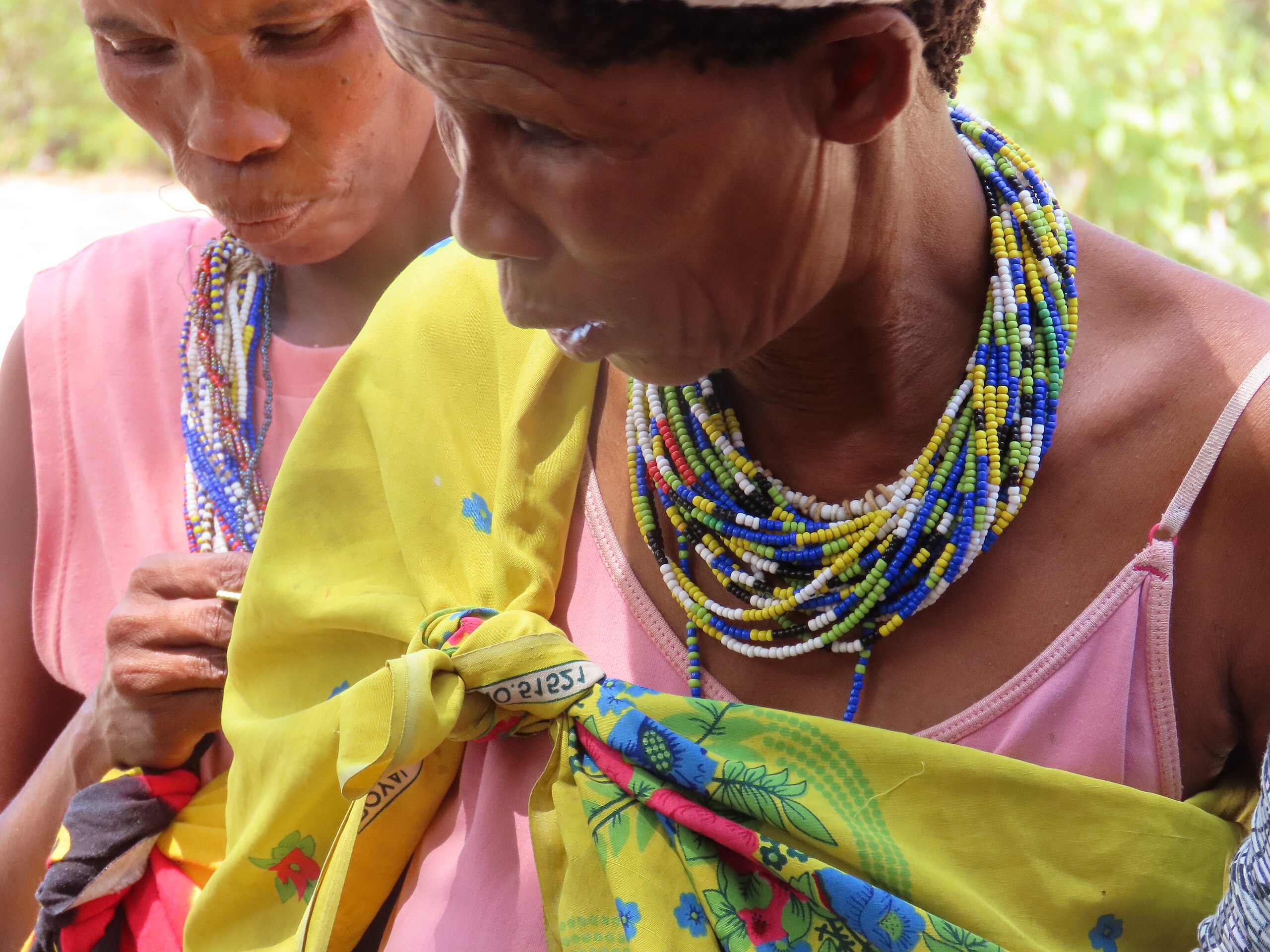 Shikoha Tautiko, CC BY-SA 4.0, Wikimedia Commons
Shikoha Tautiko, CC BY-SA 4.0, Wikimedia Commons
How do gender roles affect the community?
This is said to greatly reduce harmony and peace within the community, and is one of the biggest reasons why some !Kung choose to keep to their traditional lifestyle, even without the modern amenities.
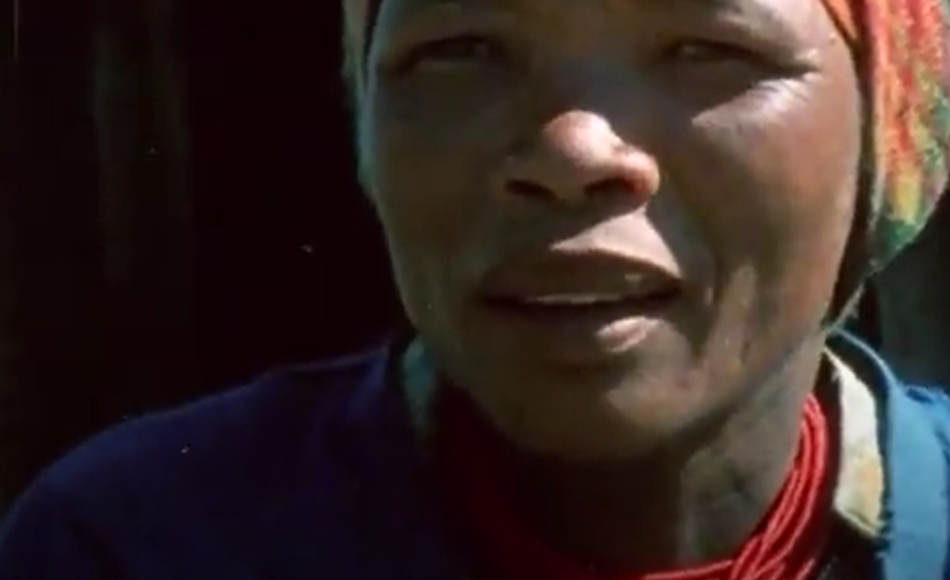 Documentary Educational Resources, Nǃai, the Story of a ǃKung Woman (1980)
Documentary Educational Resources, Nǃai, the Story of a ǃKung Woman (1980)
What is the fate of their future?
Traditional nomadic !Kung today may have avoided settlement thus far, but it may not be long before they are without a choice. Their lands are still being sought after by cattle ranches, wildlife reserves, and state governments. As their food supply dwindles and their safety becomes compromised, they are slowly losing their freedom of choice.
The settled !Kung are not any better off either. They are currently seeing an increase in domestic violence, disease, and alcohol consumption.
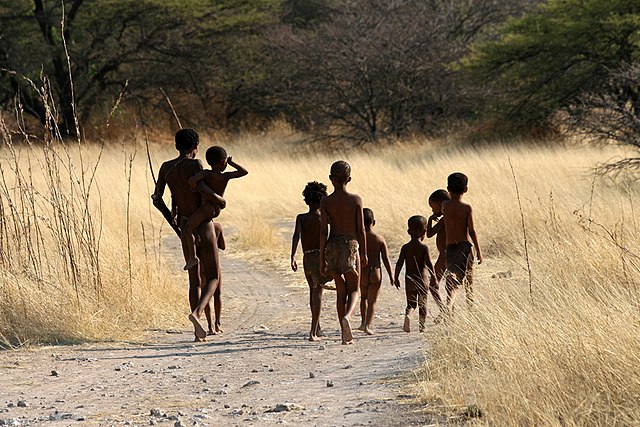 Frans-Banja Mulder, Wikimedia Commons
Frans-Banja Mulder, Wikimedia Commons
Final Thoughts
While the majority of !Kung people live in settlements today, there is still a small number of bands that continue to live their traditional nomadic, hunter-gatherer lifestyle.
Though with land encroachments becoming more prevalent, the !Kung, along with many other Indigenous peoples are at risk of losing their land, along with their sense of identity.
In order to preserve this unique culture, land preservation and protection is needed, and forced colonization must come to an end.
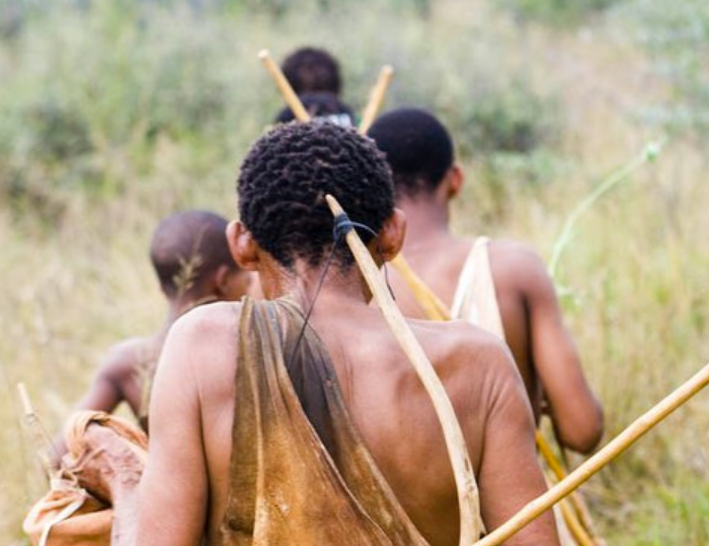 Alwynvanzyl, CC BY-SA 4.0, Wikimedia Commons
Alwynvanzyl, CC BY-SA 4.0, Wikimedia Commons


